Category: travel
You are viewing all posts from this category, beginning with the most recent.
Jane Can not Control the Weather
This morning we woke up to a bit of broken sunshine at our campground. The water was as smooth as glass. A bit of rain left over from last night was dripping down on the top of the camper. We got packed up and headed out to Port Townsend to catch the ferry to Whidbey Island. When we arrived the man working the booth warned us that due to high winds and the tides today there was a pretty strong chance that our ferry would not run as scheduled. A quick check of the weather app confirmed that the high winds were due to get worse as the day progressed. Sure enough as the time to board came closer the announcement came that the ferry would not run. A quick consultation with the man working the booth advised us that Kingston was not having any of these problems and that we should head there as the next ferry was also likely to be cancelled.
So, here we are at the Kingston Ferry waiting our turn to load. As we wait I noticed a ferry worker measuring the clearance of all of the campers. Jane had read that at low tide there can be an issue with getting on and off the ferry if you don’t have enough clearance. But, we are safely on the ferry now ready for the trip across. When we arrive in Edmonds we will take advantage of our new drive to stop at REI to exchange my defective hiking boots, then hit Costco to refill the tank and finally head to our campground. What should have been just an 80 mile day is turning into 160 mile day. The campsite was a bit of a challenge to get into and get the camper level, but we are getting quite good at it now.
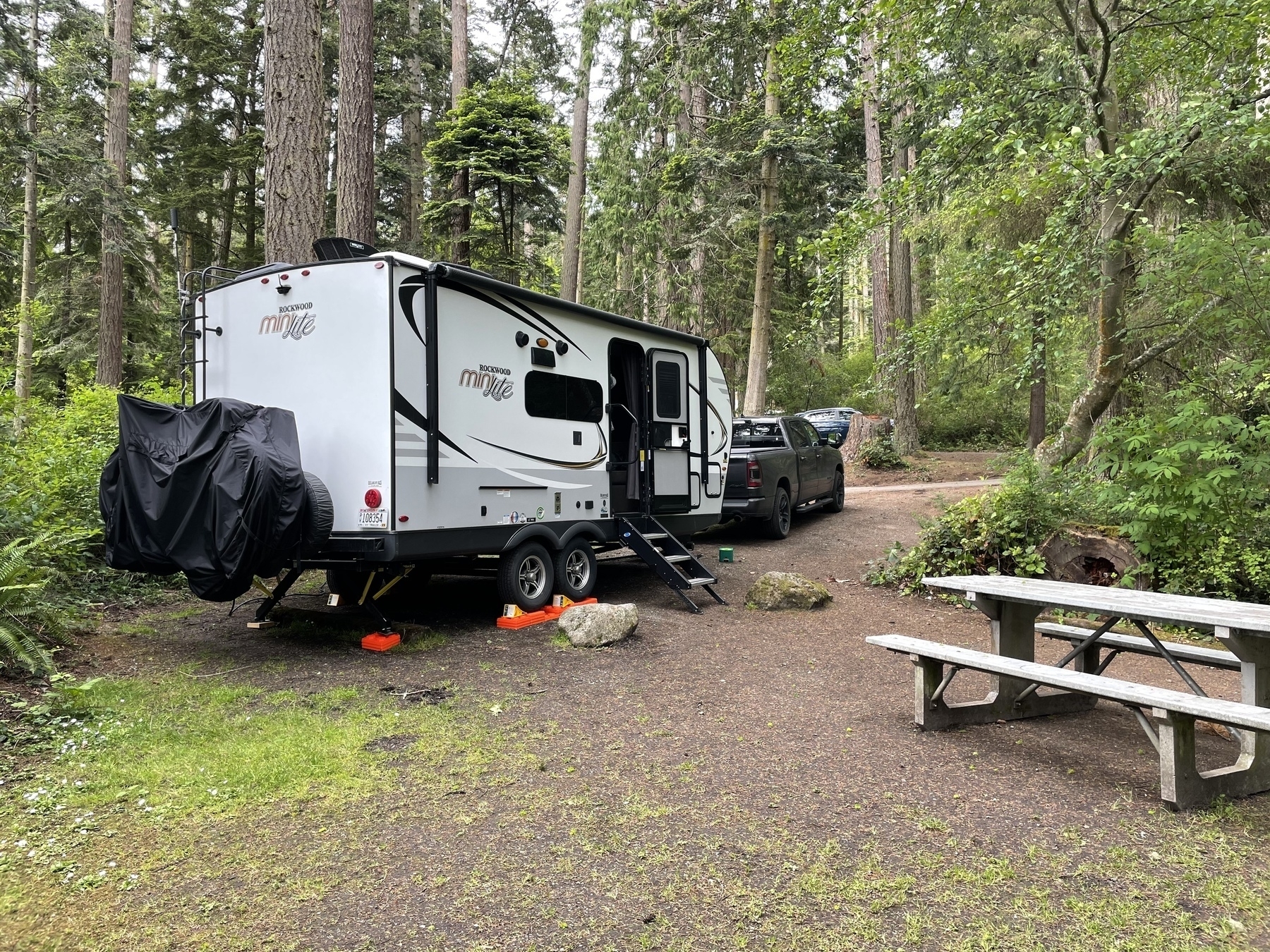
For dinner we had a real treat! We met Jane’s cousin Jeff and his wife Barb, whom we met a few years ago in Seattle, and another cousin David and wife Mary for supper tonight at Nell Thorn’s Waterfront Bistro in the nearby town of La Conner. Yum!
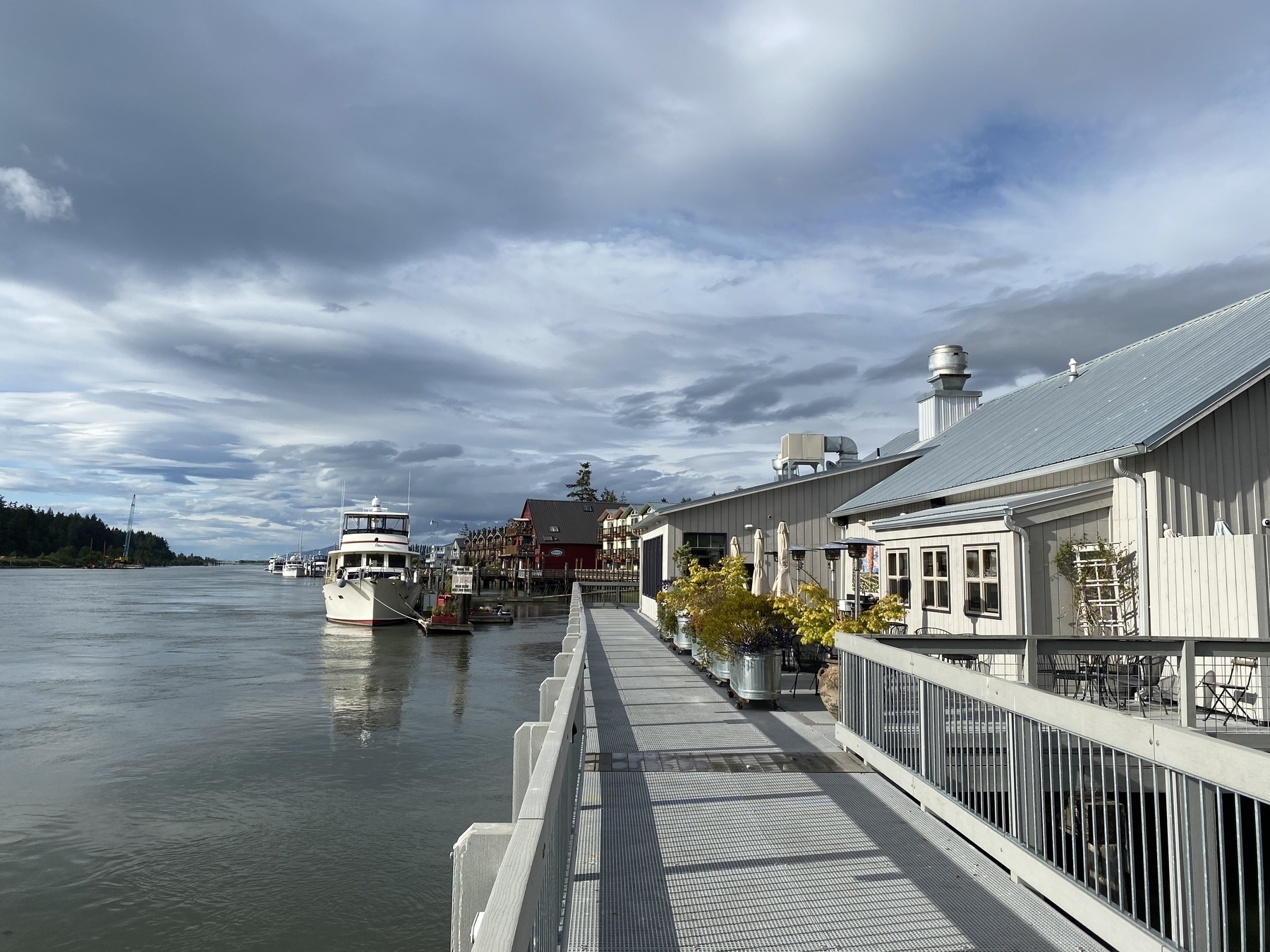
I had a delicious crab pasta, but my favorite was the crispy polenta with gorgonzola sauce! It might be the richest thing I’ve had to eat in a year. We had a wonderful dinner and great conversation. We also learned that another of Jane’s cousins owns a restaurant in Leavenworth called Viscontis. I hope we get the chance to try it as the reviews and food look very good!
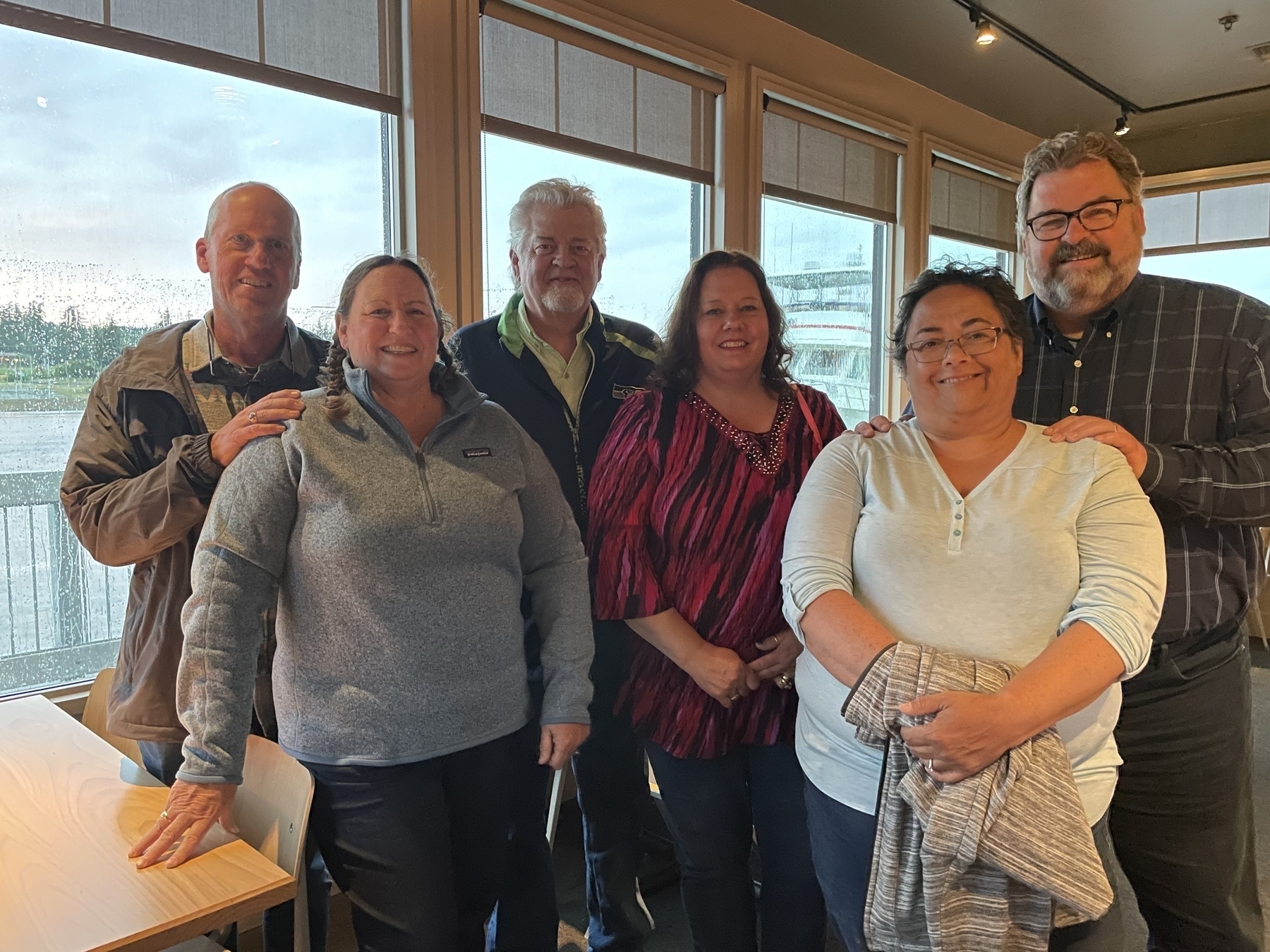
On the way back we were treated to a bit of rain and a beautiful sunset.

More Photos from today and 1986
This morning we went through all the weather in about 30 minutes! We started out at our Salt Creek campsite, where the forecast was for 60 and overcast most of the day. But as we climbed toward Hurricane Ridge we got into the low clouds and rain. The temperature was dropping quickly as we went up, but then we emerged from the cloud into beautiful bright blue sunshine and we had the joy of looking down at the top of the clouds!
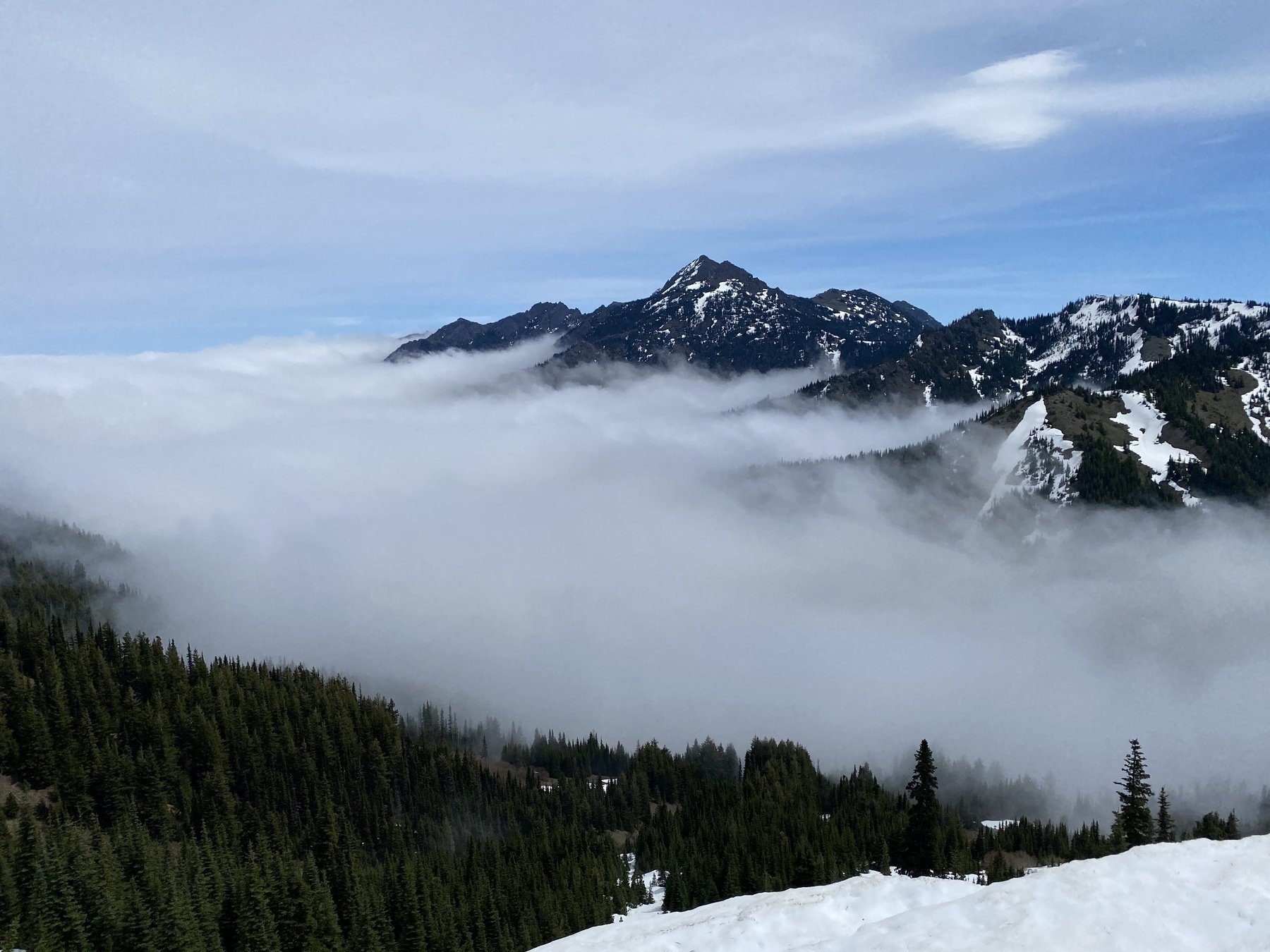
In our fun quest to retrace our steps were trying to find the place where we took a couple of pictures on Hurricane Ridge. I apologize for the short shorts! It was the 80’s after all.
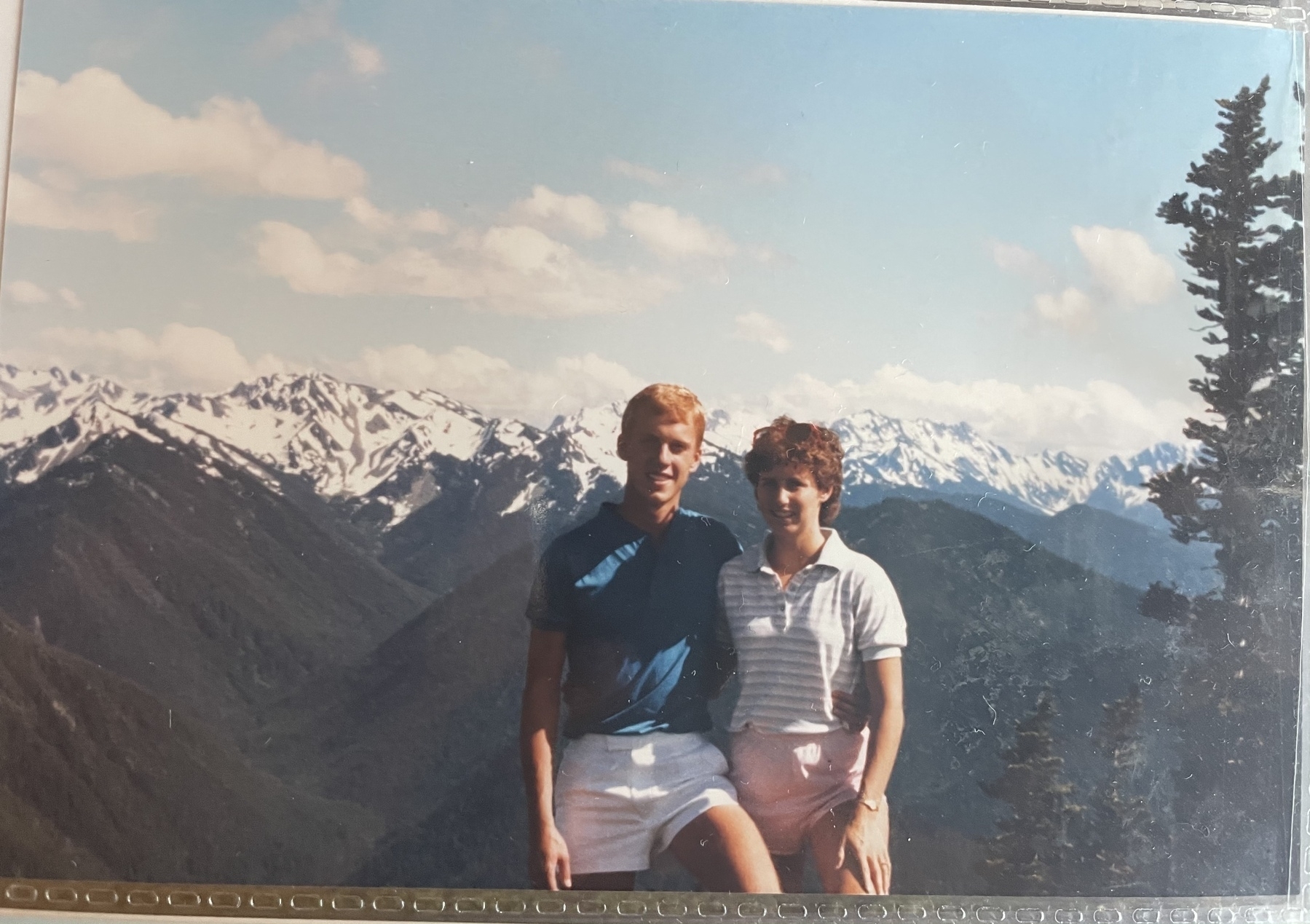
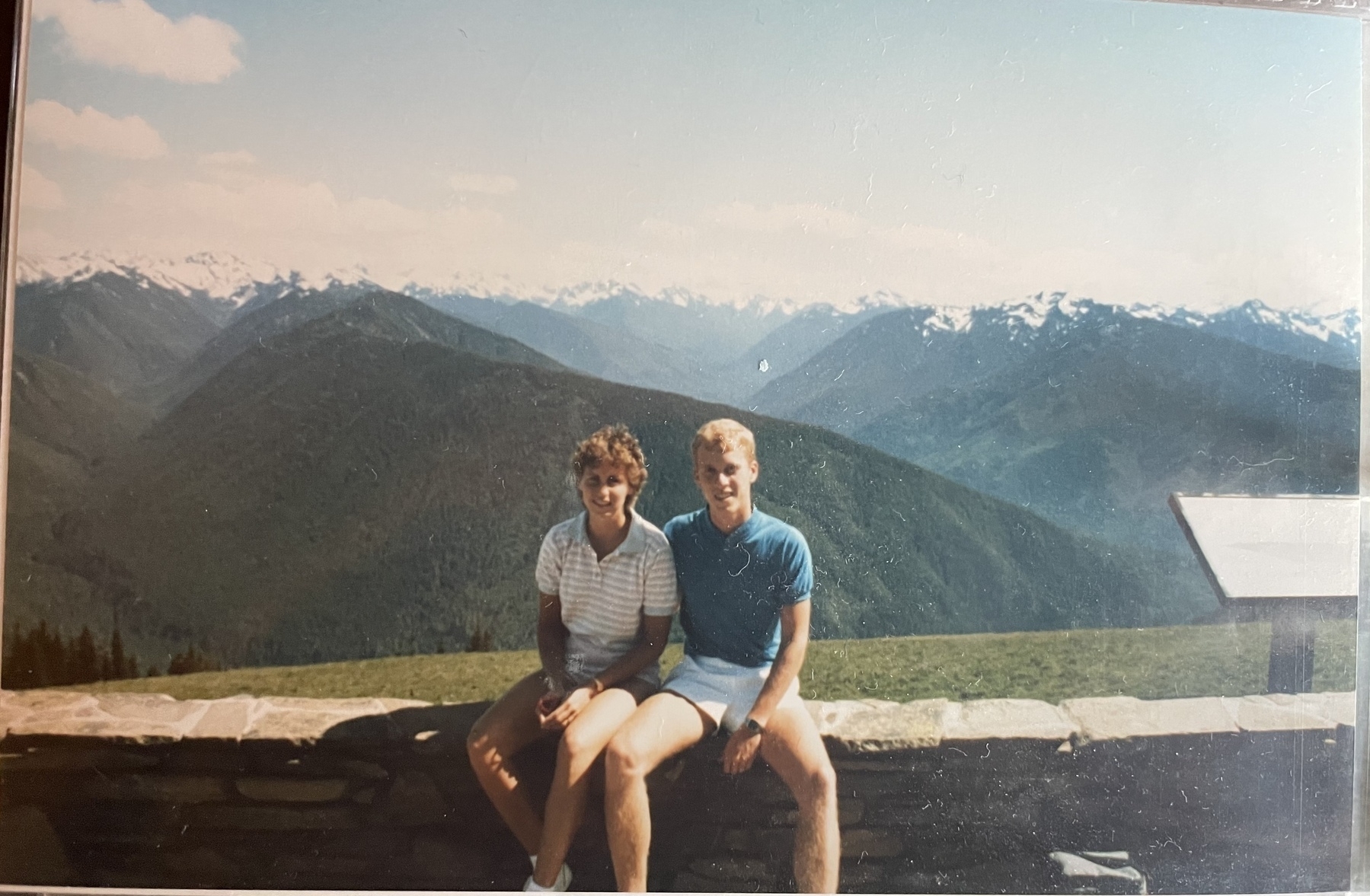
Here are today’s photos:
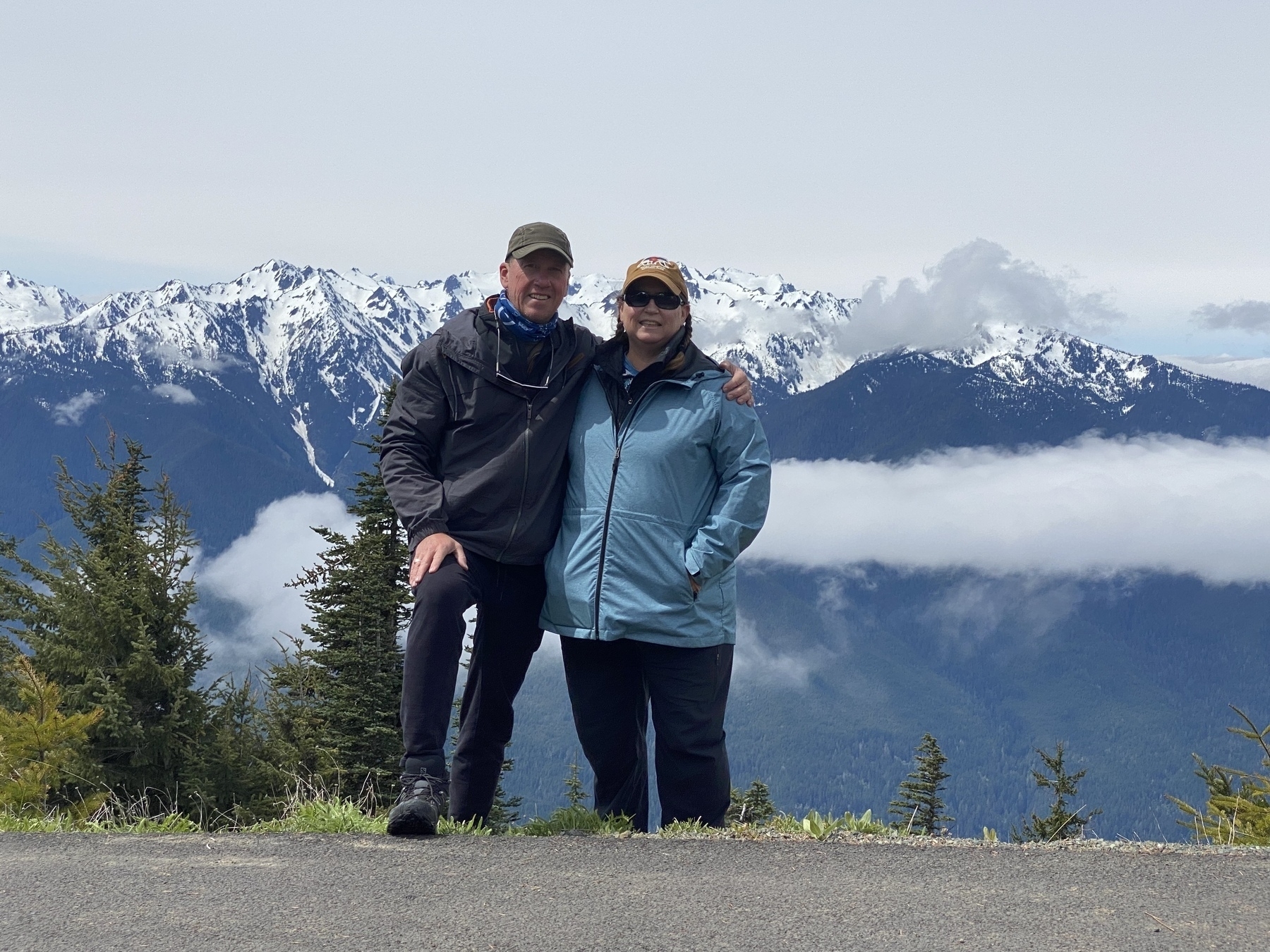
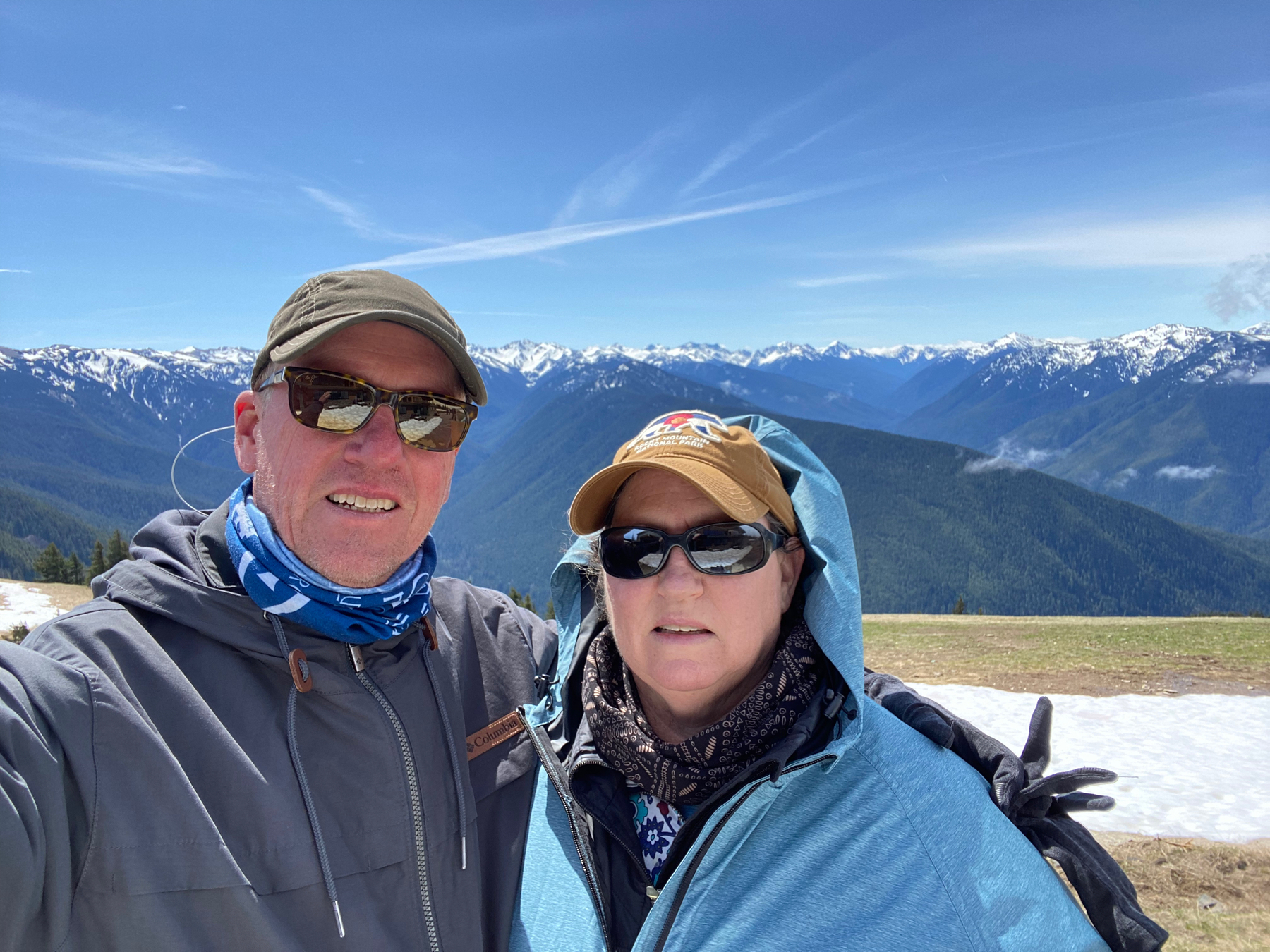
We did a little more hiking to enjoy the spectacular views!
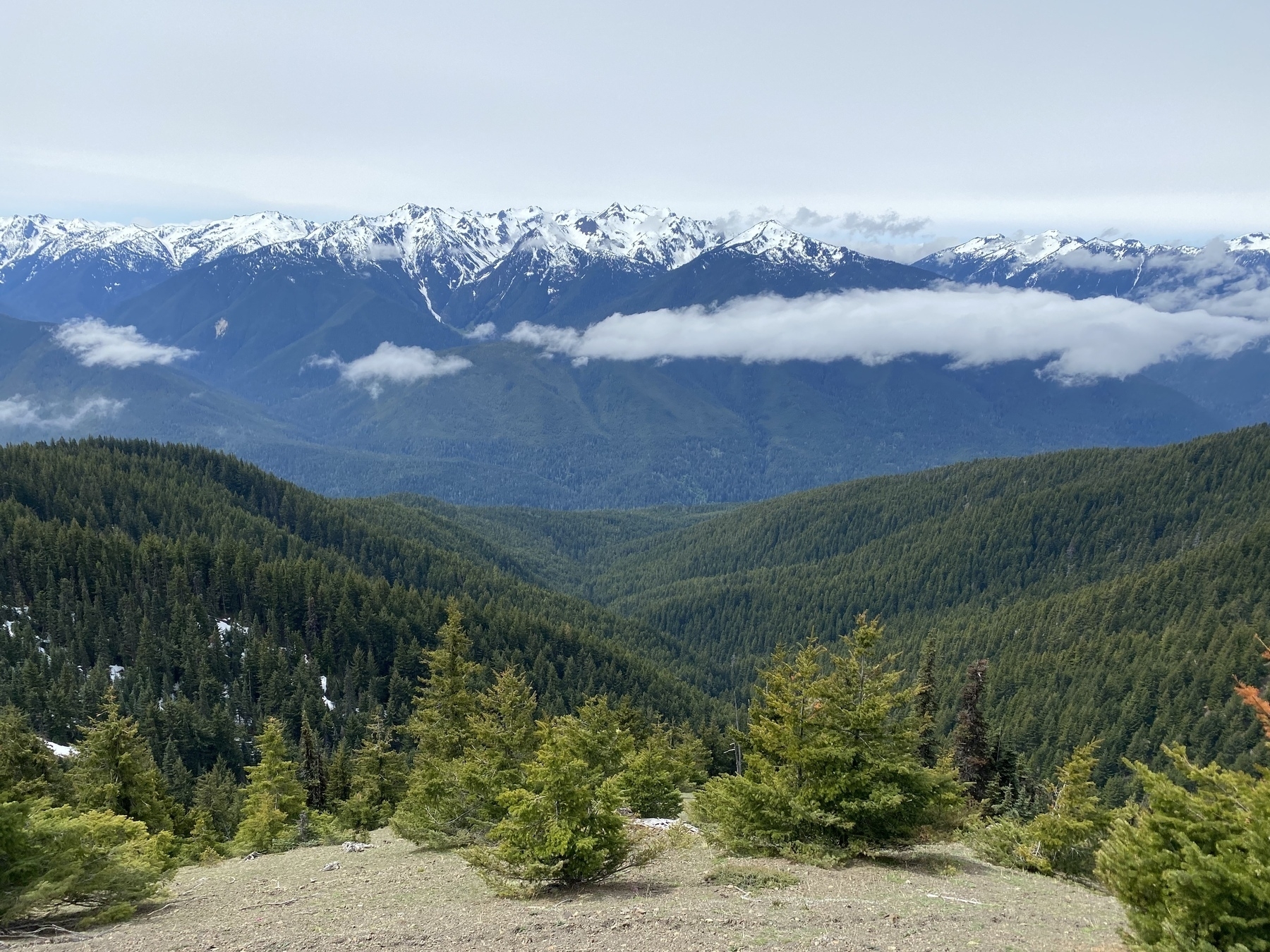
Then we were off to find Marymere falls!
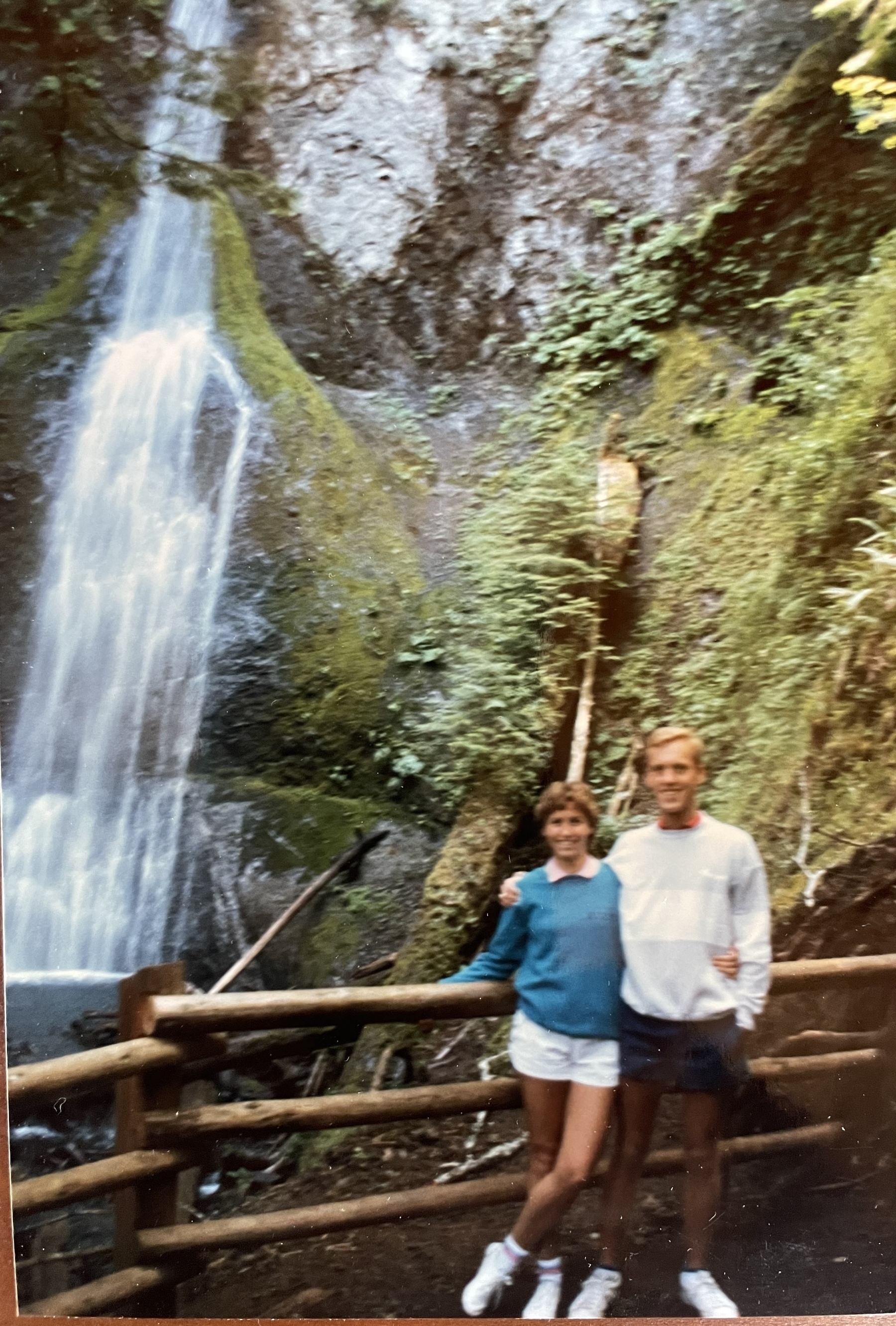
I’m not sure who took the photo in 1986, but they managed to make it a little blurry. This time it was very sweet. We were getting ready to do a selfie at the falls when the young couple behind us asked if we wanted them to take our picture. Sure, I said, we are trying to recreate this photo from 35 years ago I said. It is from our honeymoon, Jane added. This young couple had just gotten engaged. So they took our picture and added that 35 years was a long time and certainly something to aspire to. Oh my.
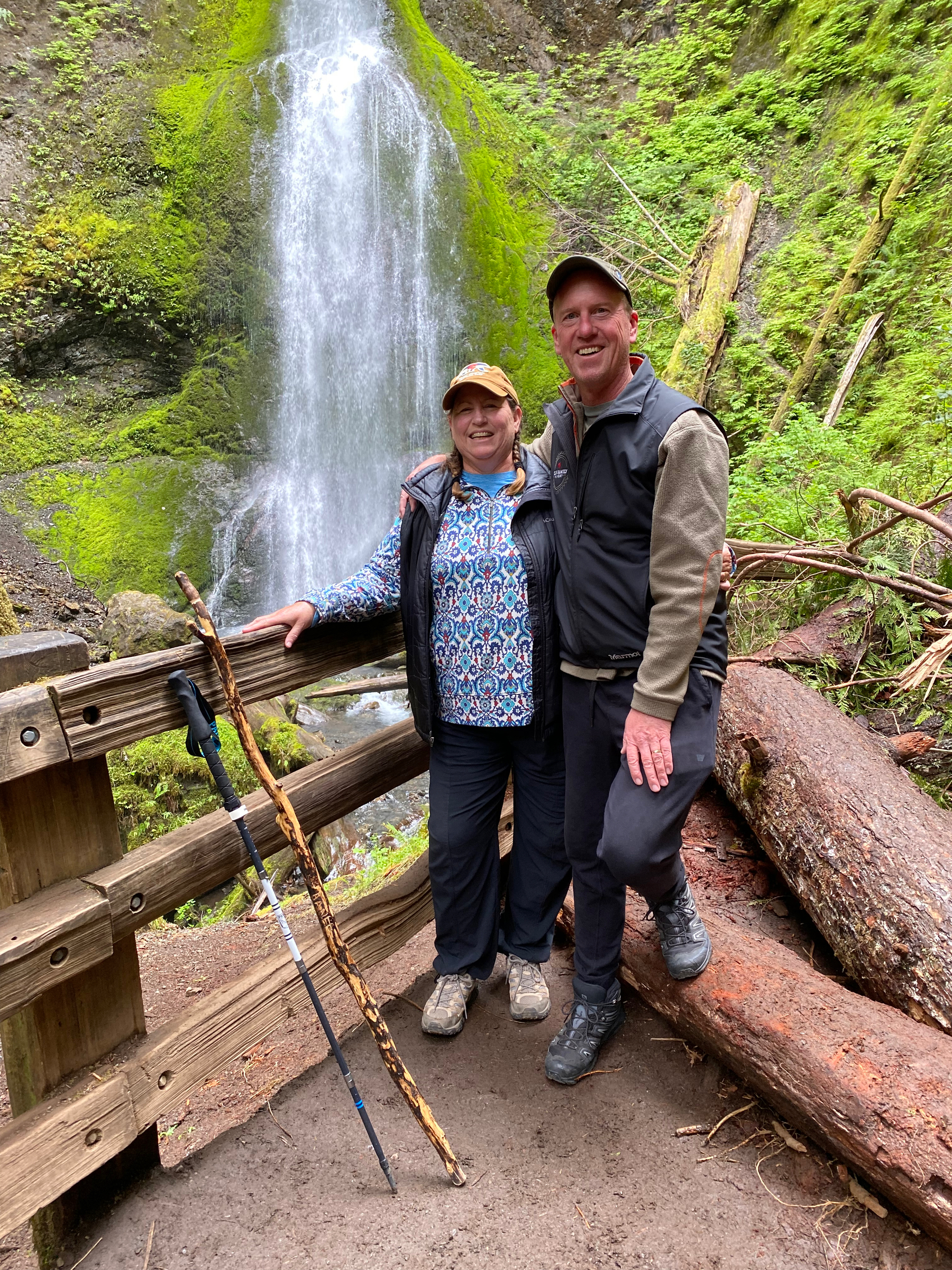
As we were headed back down the trail, I noticed that the bridge we had just crossed looked pretty familiar. It is the bridge below.

With my darker clothes it was impossible to even see me, when zoomed out. So here is a slightly zoomed in version of the same picture.
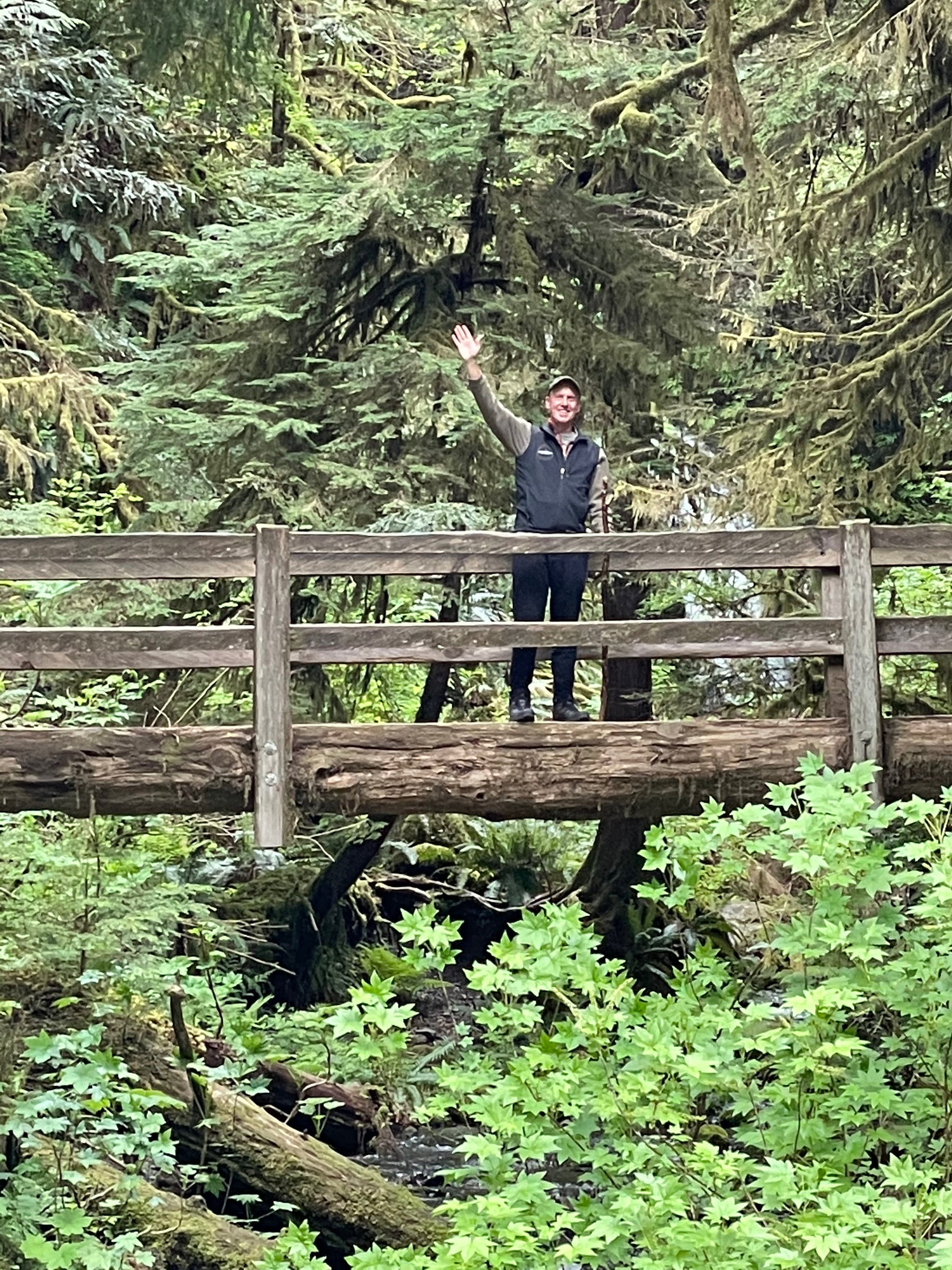
And last but not least, here is Jane crawling through the tree. As John Carlis used to say, never let the facts get in the way of a good story, so we are going to say that this is the exact same tree, with 35 years of growth and reshaping of the hole!
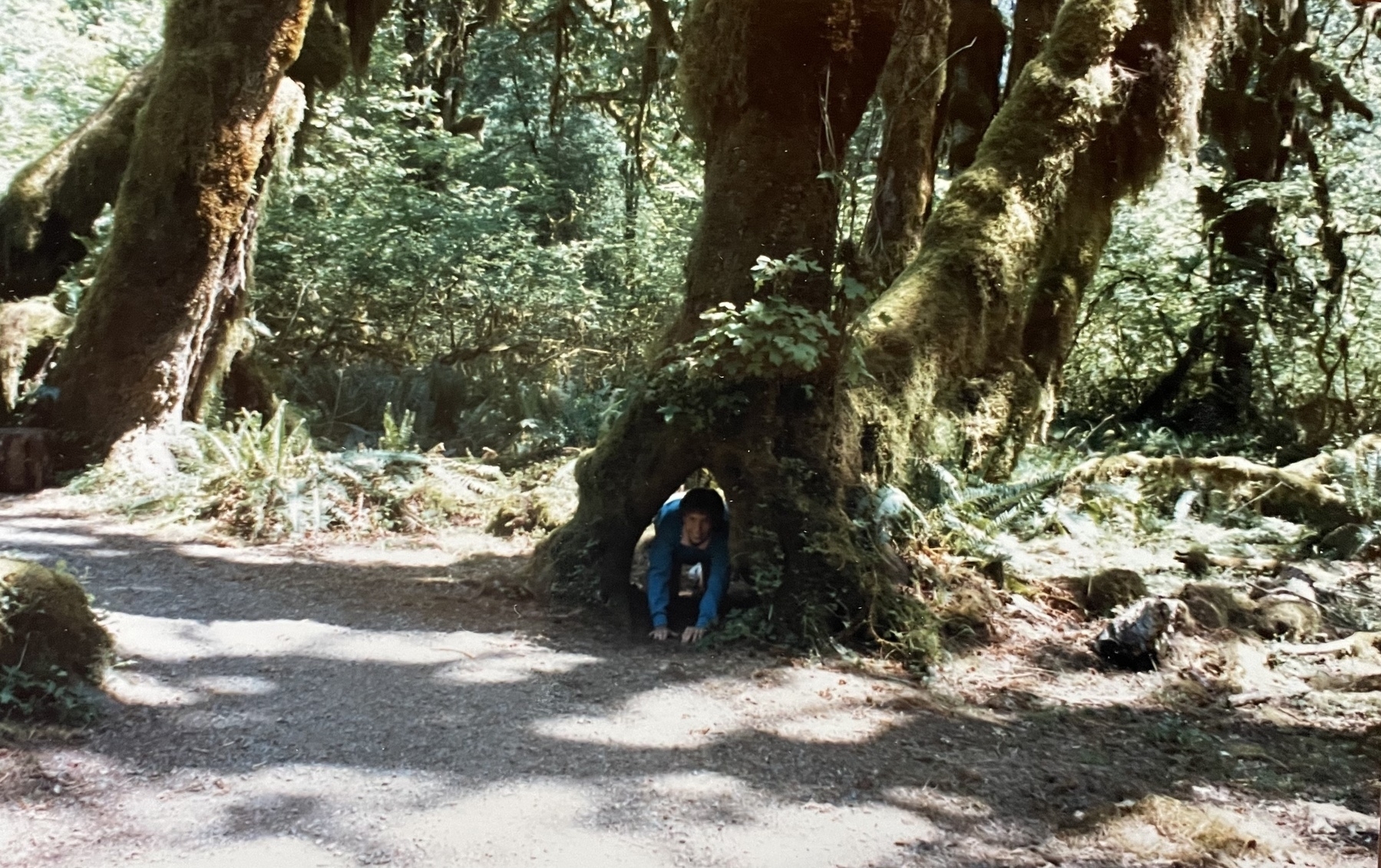
The opening has changed, but Jane’s sense of adventure is still the same as it always has been!

Ok, here ends the nostalgic photos from 1986. We have had a blast the last two days trying to find the right spot and angle. It is amazing how similar some things are and how much some things have changed! Ruby Beach is nearly identical to what it looked like 35 years ago. The moss covered log at Marymere is nearly identical! Yet the branch that was sticking out and up is gone with no sign of it.
Tomorrow we leave the peninsula and take a ferry to Whidbey Island!
The Avenue of the Giants
8:00 This morning we are getting an early start and I’ve decided to record this in real time, or at least near real time. We have another 50 miles on Highway 1, so more slow going on twisty winding roads. I’m writing this as we go today. We have left the coast and are amongst the redwoods. The road is super narrow but lined with trees, its just beautiful the way the sunlight filters through creating shadows all around us. There are few turnouts , so no real opportunities for taking photos.

9:25 still a few more miles to go before we get to the 101.
9:39 Just saw our first advertisement for the “Drive Through Tree”! We will not fit, but hopefully we will see it.
9:45 We are on the 101, but a sign advises us that there are sharp curves for the next 9 miles and we are advised to slow down. 😜. Lots of tourist traps for “tree houses” and Confusion Hill House, and the “one log cabin!” An entire log house made out of a single log. It looks like more of a hobbit house or a culvert with a door, but whatever.
9:52 We are on the freeway, at least for a short time…
10:03 - the legend of bigfoot! complete with three highway patrol officers with their lights flashing. I guess we will not stop to buy any bigfoot souveniers.
10:20 We are now on the Avenue of the Giants. We are heading for Founders Grove to make a stop and enjoy the Redwoods for a bit. Some of the Redwoods in founders grove are over 350 feet tall!
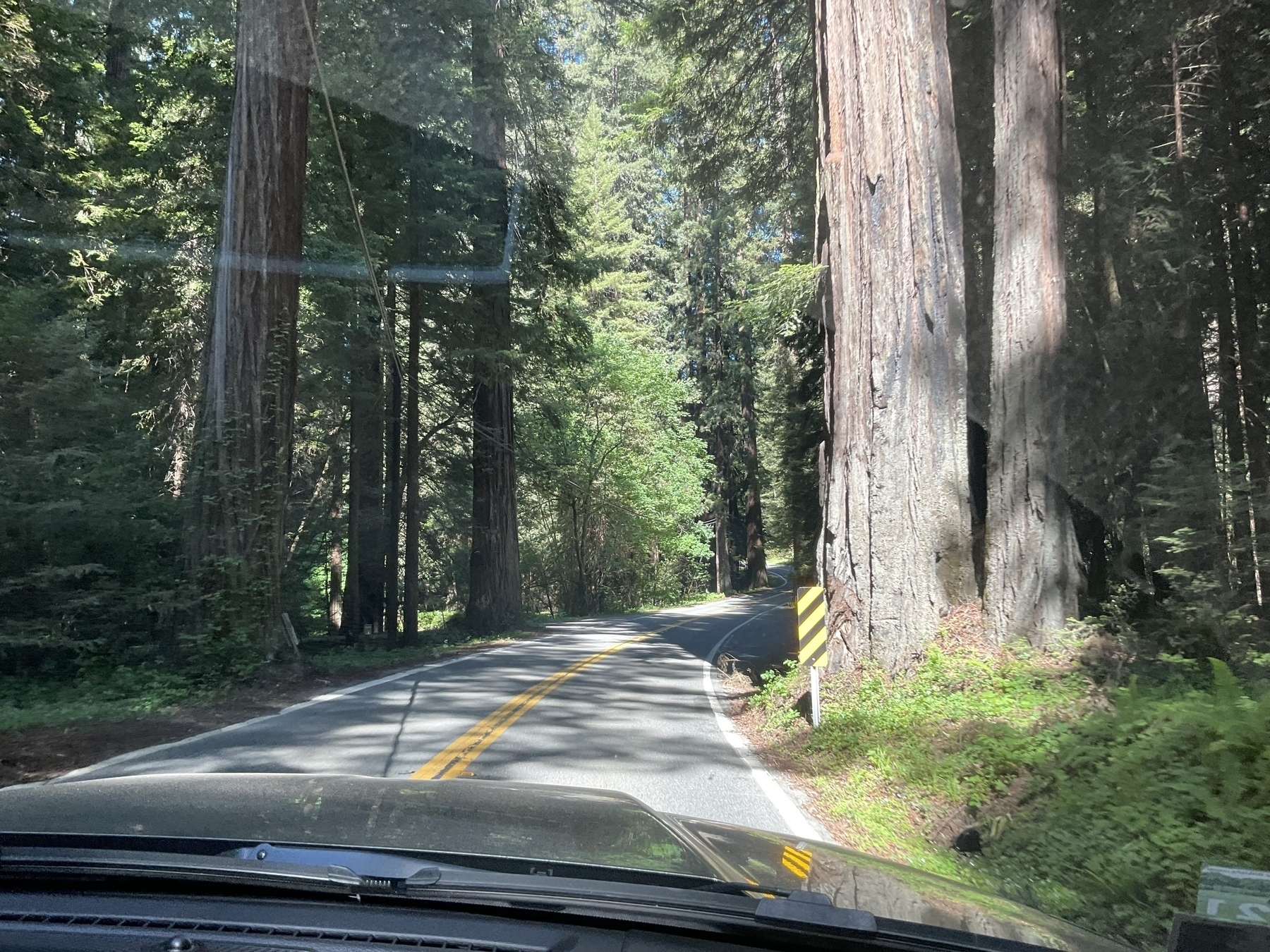
Lots of pictures looking straight up today!

11:08 Just finished the nature walk at the visitor center. Amazing! There is no way our pictures are going to capture the size and beauty of these trees!
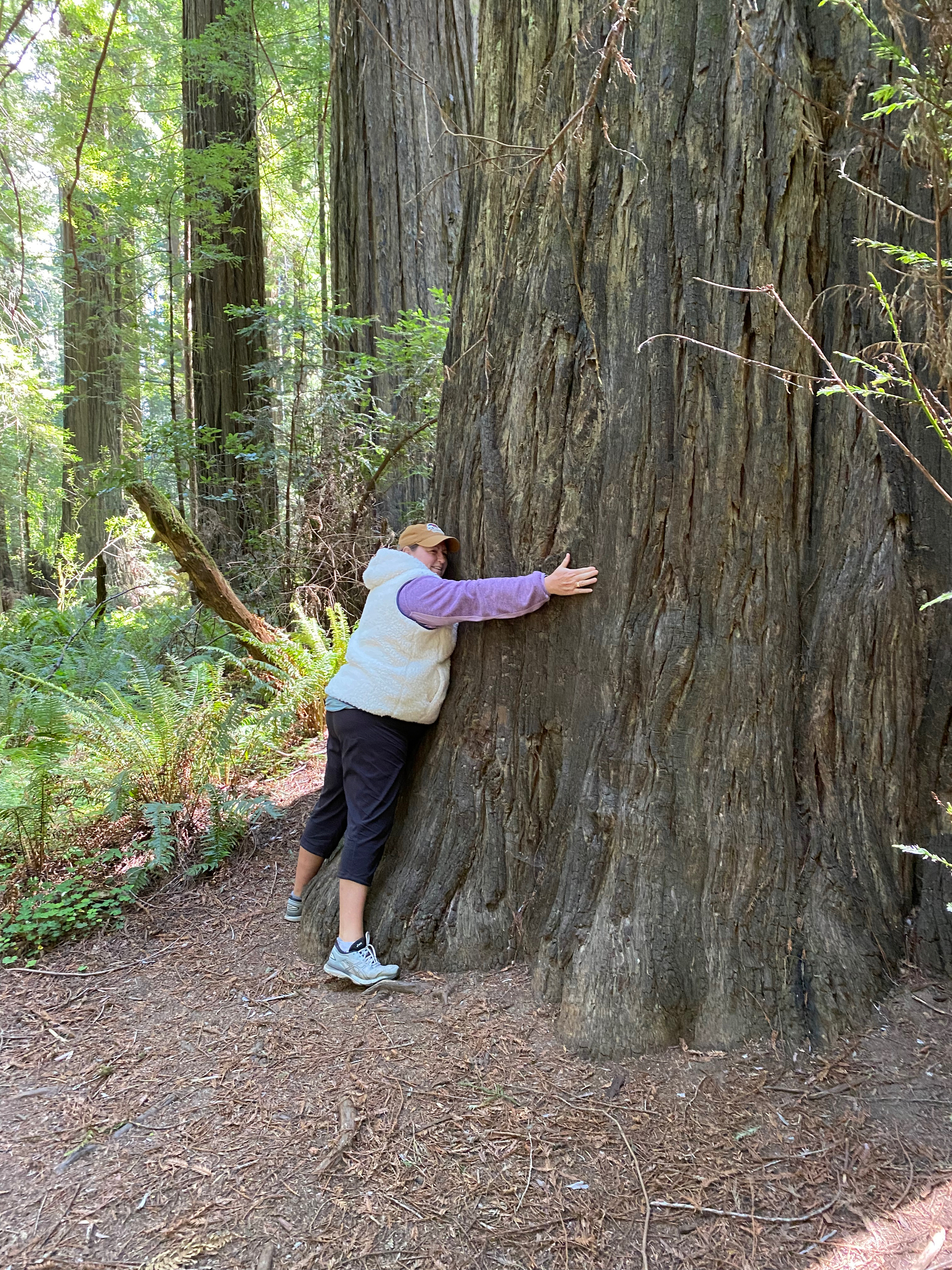
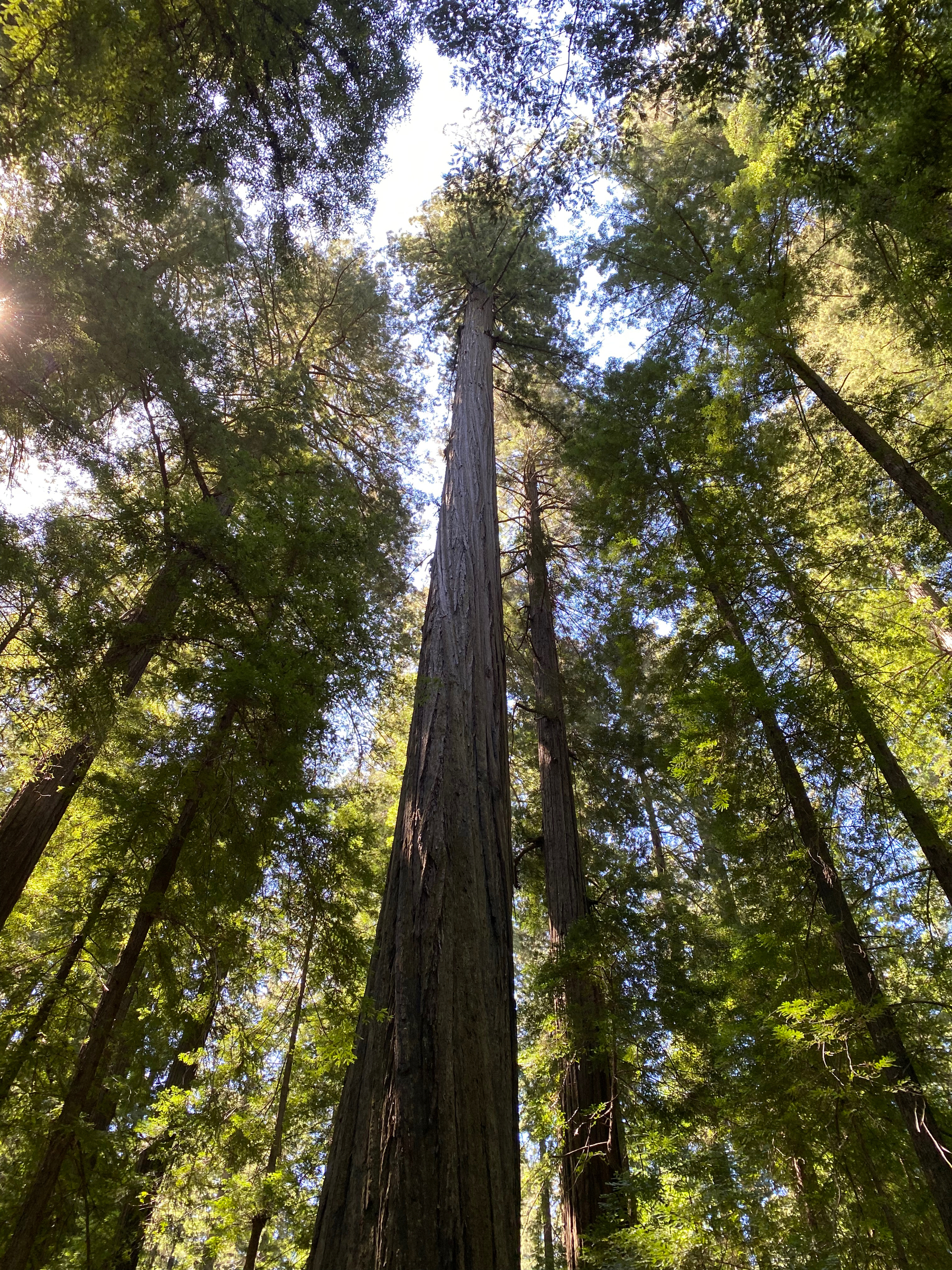
12:00 Just finished our walk at Founders Grove! Amazing, Amazing, Amazing. The Founders tree is 349 feet tall! More than a soccer pitch! The diameter is over 12 feet and the circumference just over 40
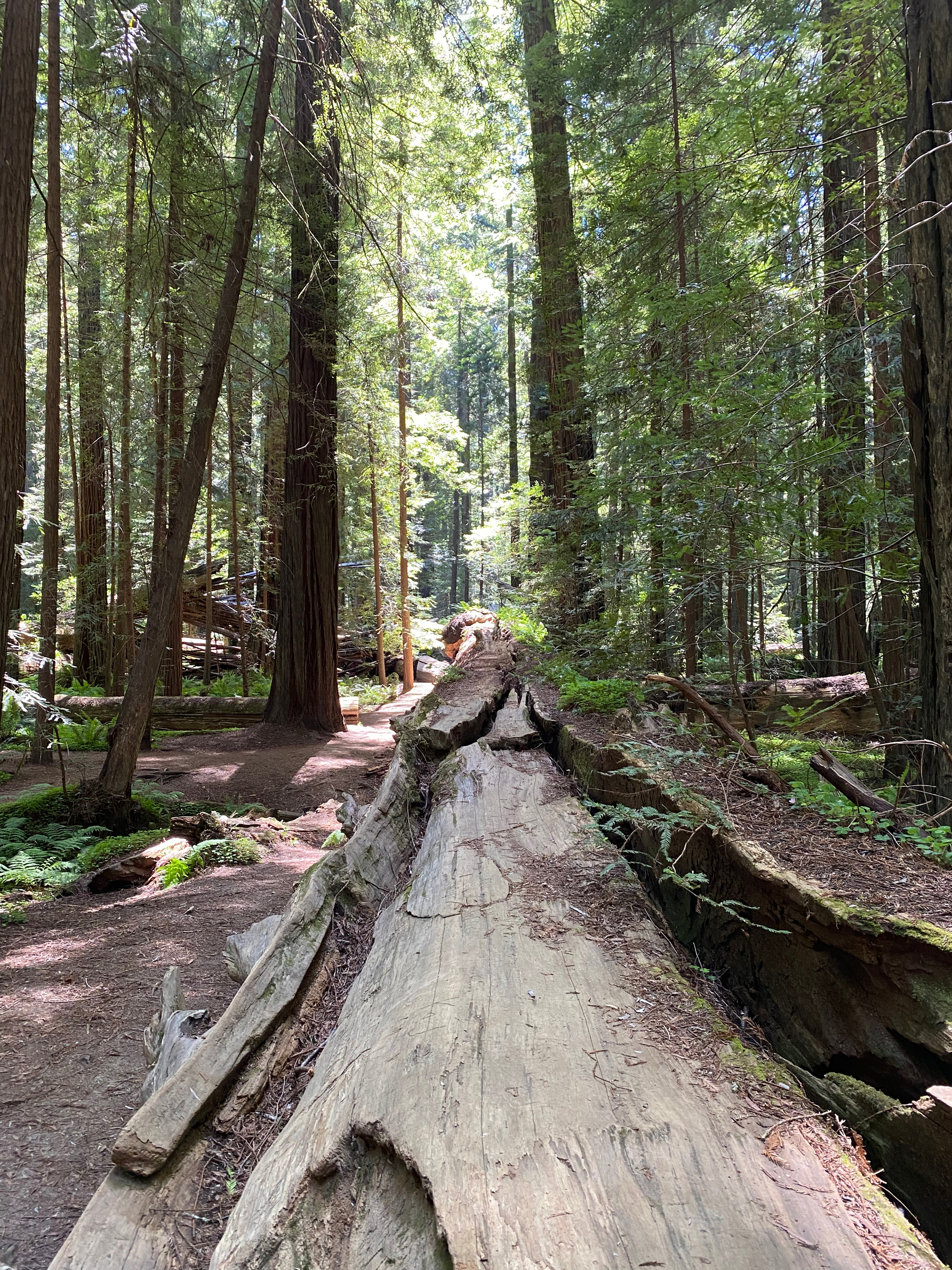

12:10 pull over by some big trees for a picnic lunch along side the road. A most picturesque lunch spot!
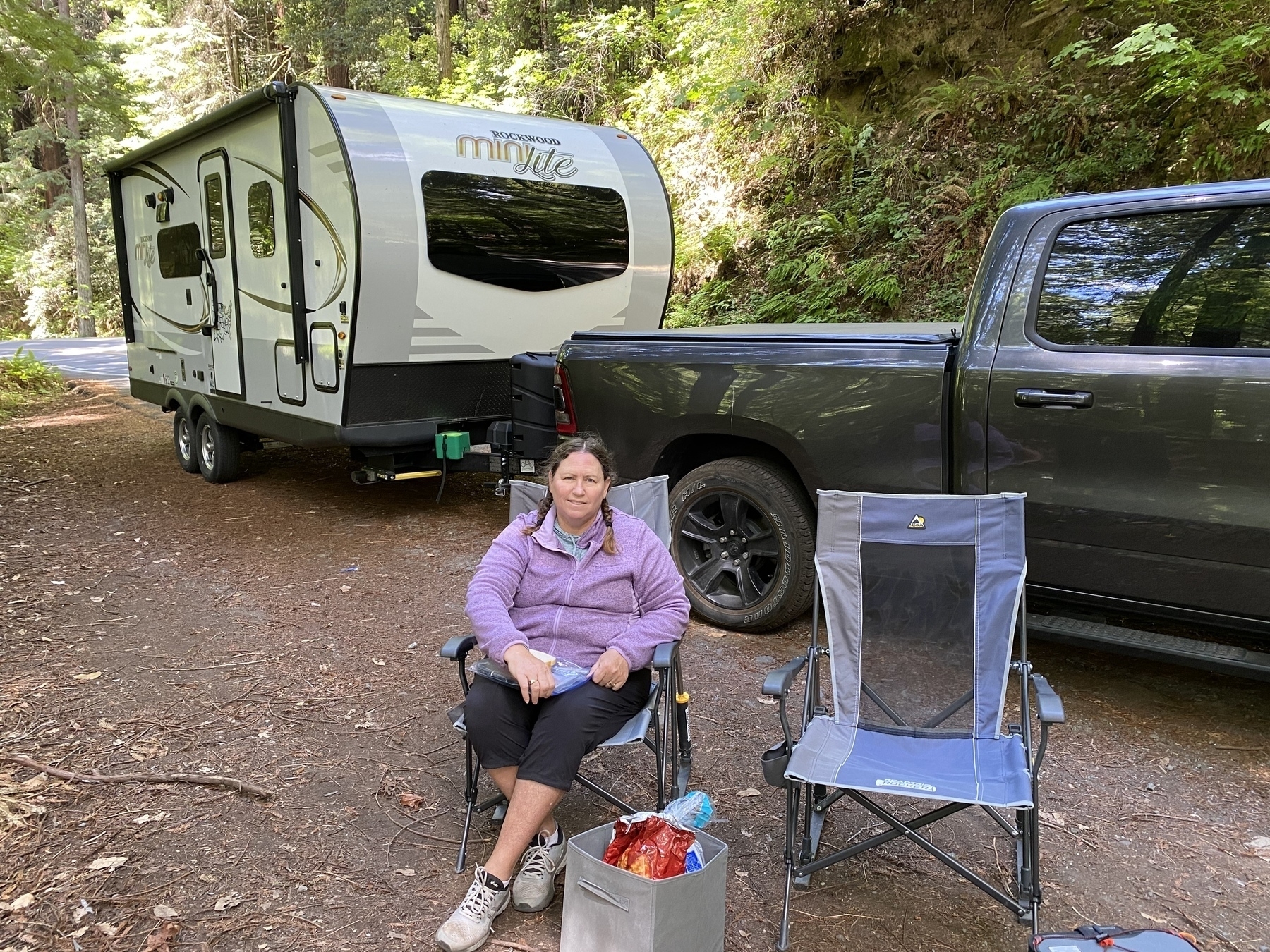
12:24 back on the road — 2:17 minutes left to our destination. The rest of the day will be on Hwy 101.
1:30 Gas stop in Eureka! Last stop before our campsite…
2:25 Arrived - Prairie Creek Redwoods State Park
2:45 We have determined that our campsite and our camper are incompatible. The site is steep and it is impossible to get our camper anywhere near level. Jane seeks out the Ranger to see if there are any cancellations.
3:00 they have two possibilities for us. After a little walk around the campground we determine that one is super small, and level, but there would be no room for the truck. Luckily the other will work great for one night. Its a bit exposed with the slide hanging right out to the road. But most sites near us are already occupied so we don’t expect much traffic.
3:45 we are finally in our campsite with the trailer leveled up and the solar panels plugged in.
4:00 we take off for a hike, having abandoned the idea of a 20 mile bike ride.
4:20 we arrive at Fern Canyon for our hike. It is for the best that we didn’t try to ride our bikes here after all. Its a steep one lane road with the barest of turnouts for when you meet someone. Thankfully the hike makes it all worth while. Fern canyon is a coastal bluff left behind by the retreating oceans years ago. The steep walls of the bluffs are covered with ferns, and the little steam running down the middle makes for a beautiful hike. Again the pictures surely do not do it justice.
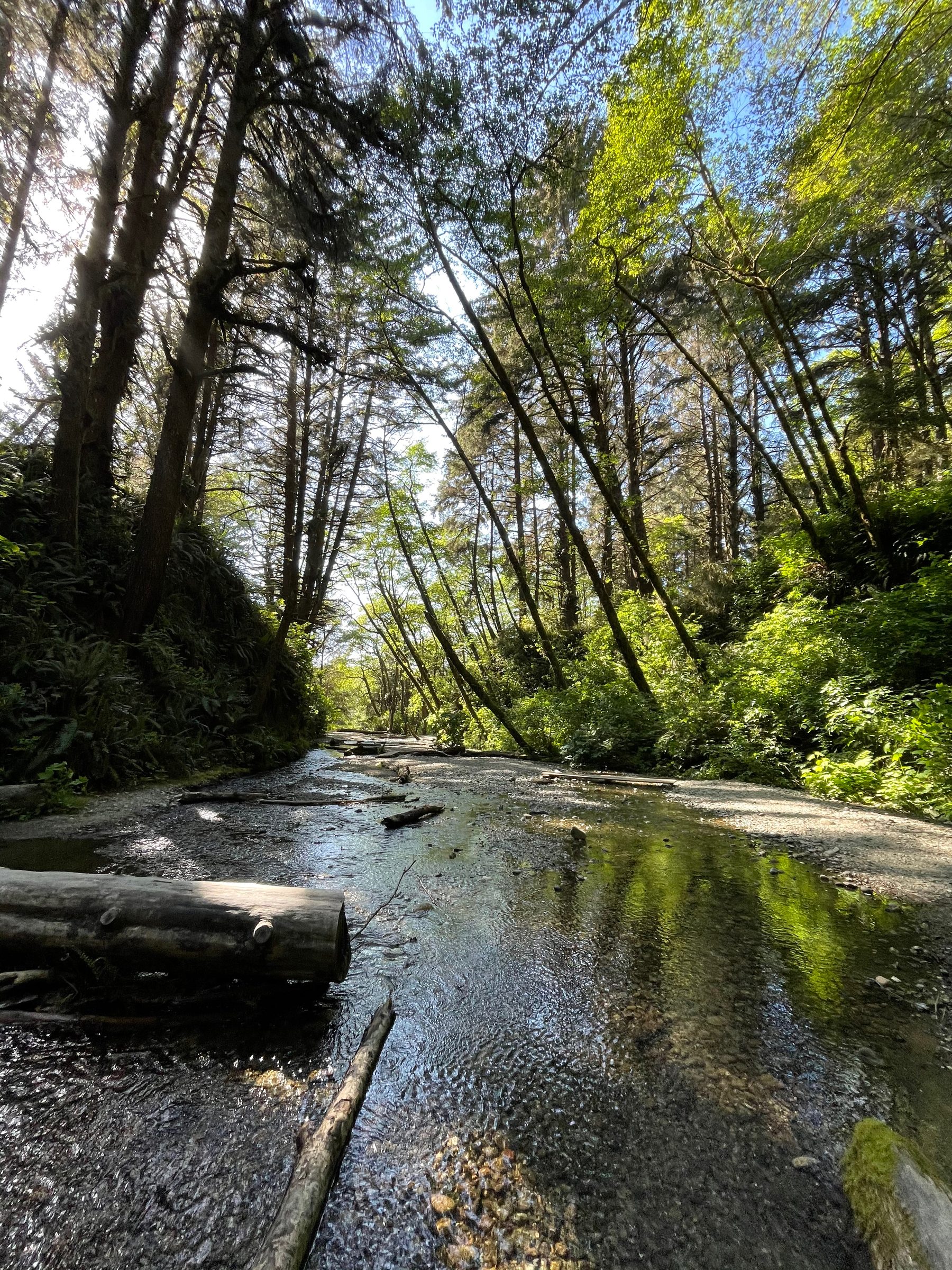
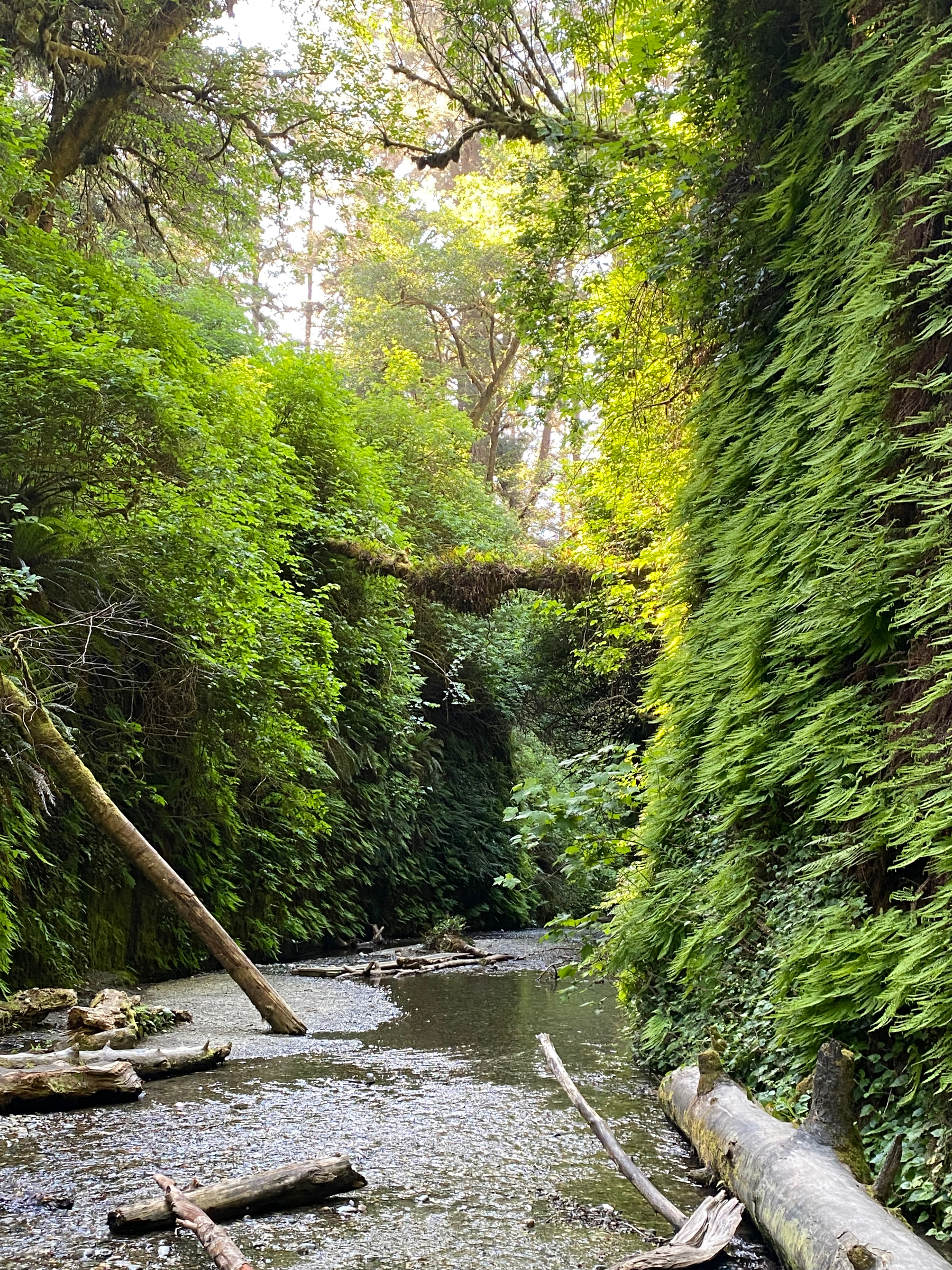
5:25 depart Fern Canyon for Lady Bird Johnson Grove. This is completely different than Founders Grove as it is higher in elevation, on a ridge top where the winds challenge the trees all the time. Its great that this is named after Lady Bird Johnson, who fell in love with this grove when she came to dedicate Redwoods National Park in 1968, but it is pretty humbling to consider that when many of these trees have been here for 1,000 years!
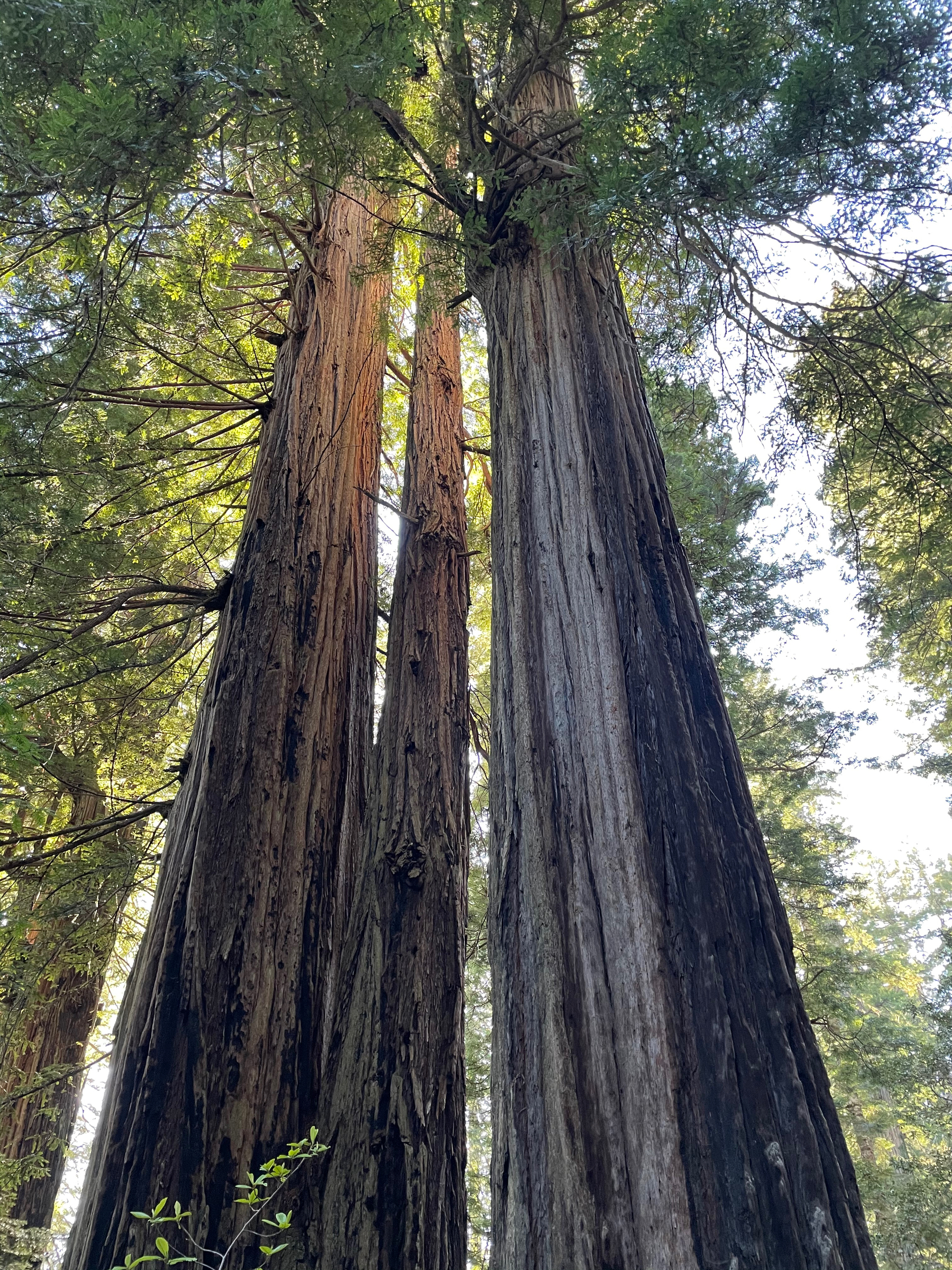
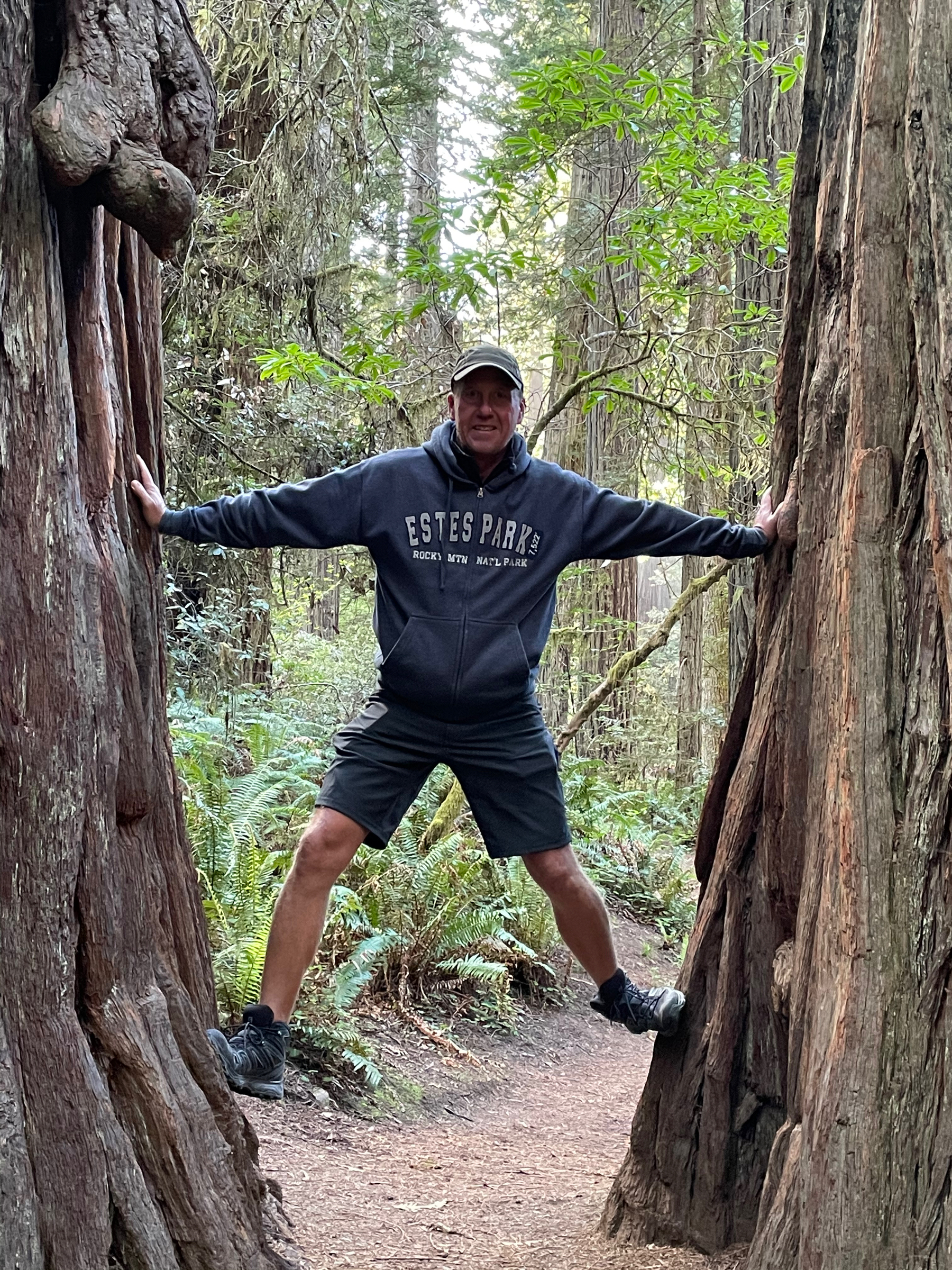
7:00 Back at the campsite! Time to make some dinner and relax. Tomorrow we head to Crater Lake where we will stay for two nights.
AI in the Dominican Republic
This all started a year ago when the government posted a travel warning for the Playa area of Mexico where we had booked a week at an all inclusive resort. Not wanting to take any chances we decided to switch to a cruise at the last minute and book a different resort. This resulted in us booking at the Cofresi Palms in Puerto Plata.
However, coming on the heels of two very long vacations I needed to make this something of a working vacation to make sure the materials for the AC201 course were as good as possible.
The Good
A couple of mornings I worked in our room, which was a really nice two bedroom suite with wonderful views of the beach. But then we discovered these covered beds right on the beach, big enough for all of us to hang out together and in the shade, with good enough WiFi for everything except video conferencing. So I switched — can you blame me?
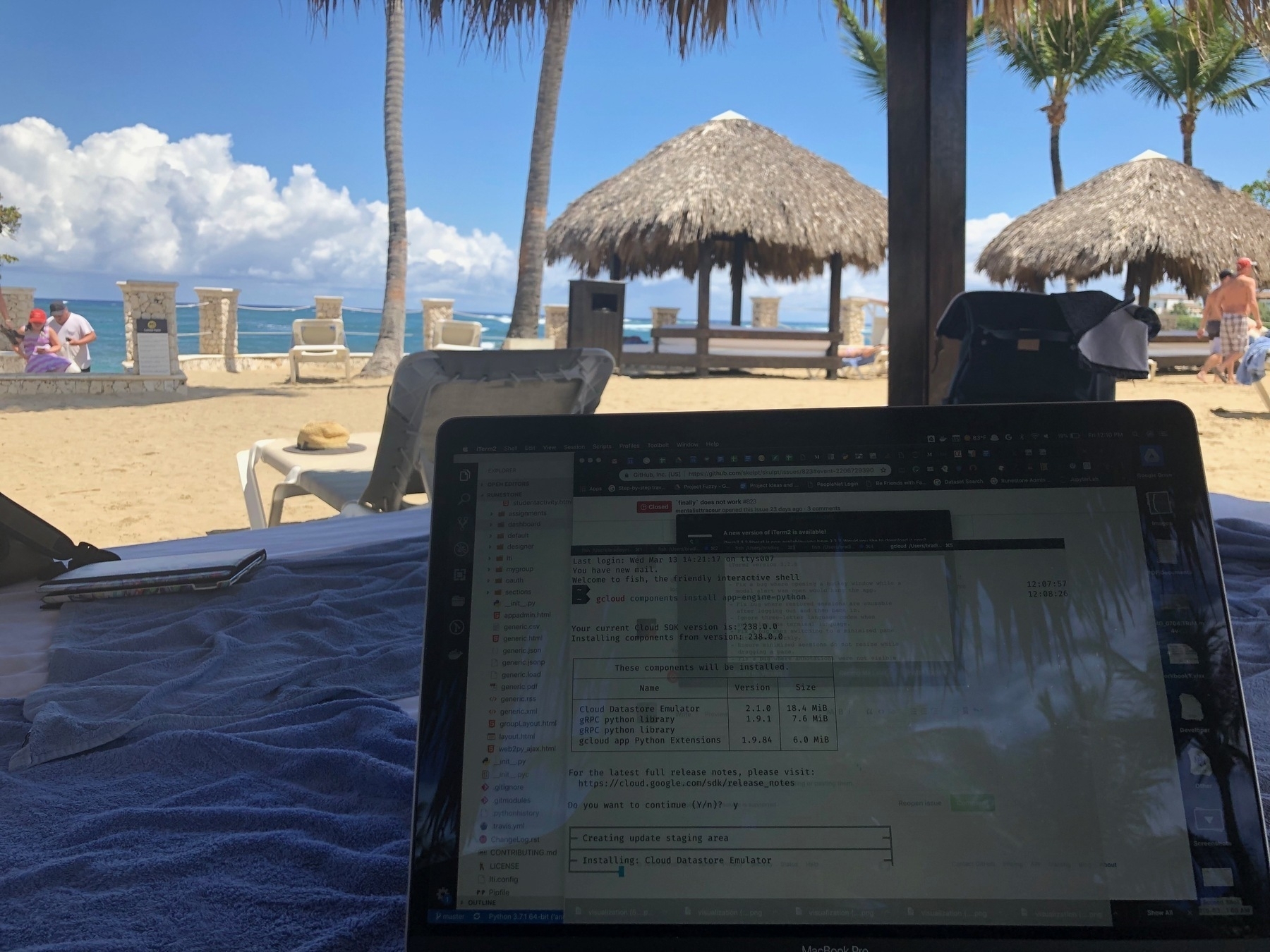
Traveling with our friends Brian and Holly is always super relaxing. Whether its hanging at the pool bar or playing cards at the beach we always have a great time. We planned absolutely no activities for this week so it was really all about reading, and lounging, which made it easy for me to mix in some work too.
This was our first ever experience at an all inclusive resort, so we had very little in the way of expectations. And mostly they were met.
A few things were a nice surprise. Our room, a “penthouse suite” was very nice. We had a living and kitchen area on the first floor with a fridge full of water, soda and beer. We also really liked the coffee pot in the room. The bedrooms upstairs were huge, each with its own deck and spectacular view of the resort and ocean. Our bathroom was fine, but in serious need of updating and new grout.
The Mexican and the Indian restaurant. We should have eaten all our meals at these two.
The Bad
We had read about the “men in the hats” before we arrived. A small army of high pressure sales people that will try anything to get you into a sales pitch situation, and invest in the timeshare. “Tours”, better breakfasts, free golf cart rides, tokens for upgrades your next time back… They really try to get you the first day, and then came at us again hard towards the end. Dodging them became a kind of sport for us.
The bands. Everyone has to wear a wristband. These identify you and your level. Lots of places are for VIPs only, so if you don’t have the right colored band you are not welcome. We were not VIPs. See the previous paragraph for another part of their sales tactics.
The cups. All of our drinks came in these tiny plastic cups. Brian referred to the beers that came in them as “beer shots”. There was one kind of beer - El Presidenté, All of the drinks were watered down, but hey what they lack in quality they made up for in quantity.
The service. I feel bad writing such negative stuff, but the staff at the restaurants was really apathetic. Sometimes we were so rushed that we could hardly enjoy our food. Other times the service was so slow that we mostly had lost interest by the time it was served. We did learn that a $1 tip could get you a lot of good will and even a smile.
The smell. Running through the middle of the resort is a cement canal with a big sewage pipe suspended in the canal. The pipe leaked. The smell permeated everything downwind, which included one of the largest pool areas in the complex.
But we still had fun
Although I’ve listed a lot of negatives, and that may be because I’m a snob. But in the end we still had a lot of fun, and spent some great time reading and relaxing. I would do an all inclusive again sometime, maybe, but it won’t be this one, and I think I have a lot of other places and things on my list.
Welcome Back to Minneapolis
Well it was bound to happen, and as we like to say, it could have been worse. Landed at MSP just before 9:00 this morning. It was 1 degree Fahrenheit (-17 C) and the snow was just starting to Fall.
The Galapagos cruise was unlike any other we have been on. High on the active scale, high on the learning new things every day scale, and with the small ship very high on the meet interesting people scale. As the hotel manager John Flynn told us, they are very well aware that this cruise is a bucket list trip for most passengers, and they really do their best to make it memorable. And that was just one component of this trip!
-
Amazon Rainforest
-
Machu Picchu and Inca trail hike
-
Cusco and the Sacred Valley
-
The Galápagos Islands
Jane and I have had so many interesting experiences on this trip that it seems like we have been gone for months, not just the three weeks.
We left Quito early this morning (12:30AM) and arrived in Atlanta by 5:30. Getting through customs and making the transfer to the domestic gates was a breeze thanks to our Global Entry passes. But neither of us ended up sleeping on that flight and we just dozed a little on the flight to Minneapolis, so we were both beat by the time we got out of the Uber in downtown Minneapolis.
In an attempt to wake up a bit, I went down to use the elliptical in our workout room. As the minutes ticked away I watched the Wells Fargo building and IDS Tower disappear into the increasingly heavy snowfall. We are supposed to get more than four inches today, and you can see that even this afternoon it is still coming down pretty heavily.
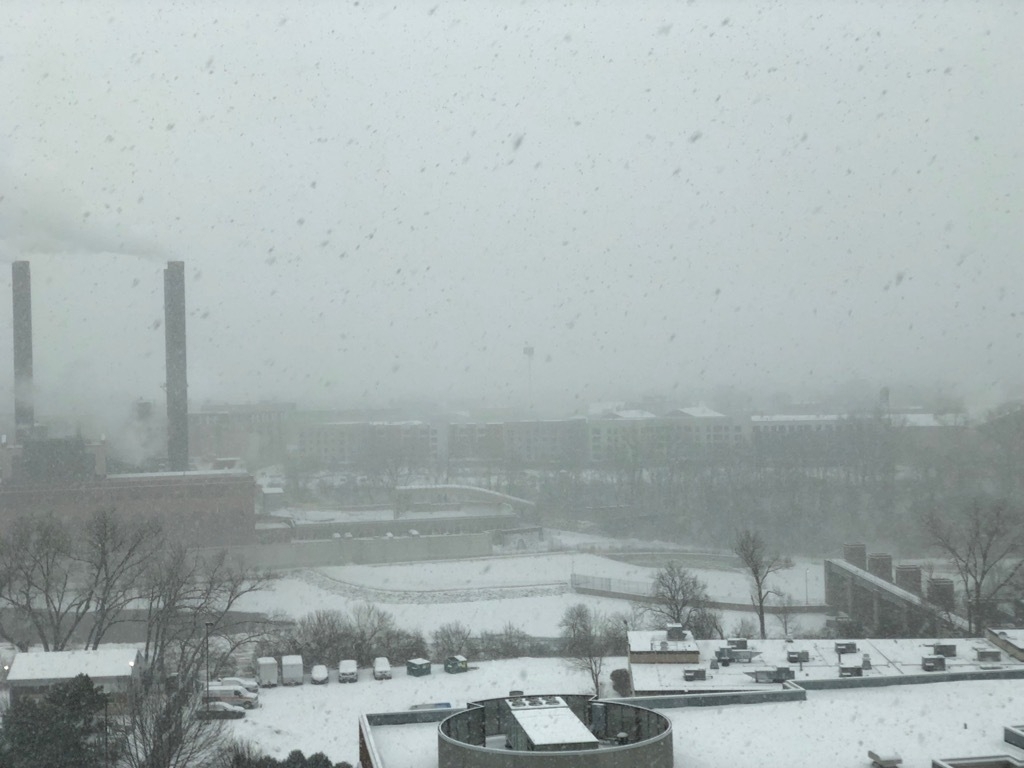
As with all good trips, we learned a lot, came to appreciate new cultures, old histories, and new parts of the globe. It’s great to get away and get a new perspective on the business of everyday life, and to evaluate one’s priorities. But as the saying goes, there is no place like home. We are happy to be back, and already looking forward to an exciting weekend of activities including a play at the Guthrie and a broadway series performance!
Darwin Research Center
We started our day today with a visit to the Darwin Research Center. One of the main projects at this center is the preservation of the many different species of tortoises on the islands. Many of which were hunted to near extinction by whalers or pushed out of their habitat by goats, dogs and cats. The tortoise in the image below is a saddle back! A close genetic relative of “Lonesome George” that last true Saddleback that died a few years back. You can see that they have very long necks which is an adaptation for eating the cacti on the desert islands of the Galapagos.
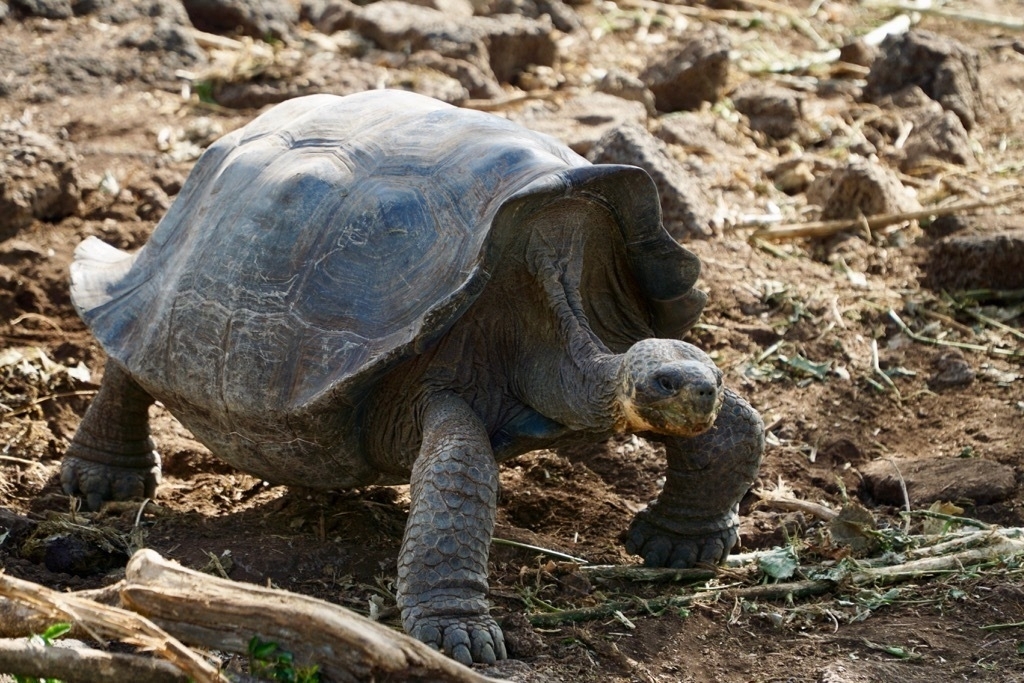
And of course we saw many of the Galapagos Tortoise both at the Darwin center and later on in the wild.
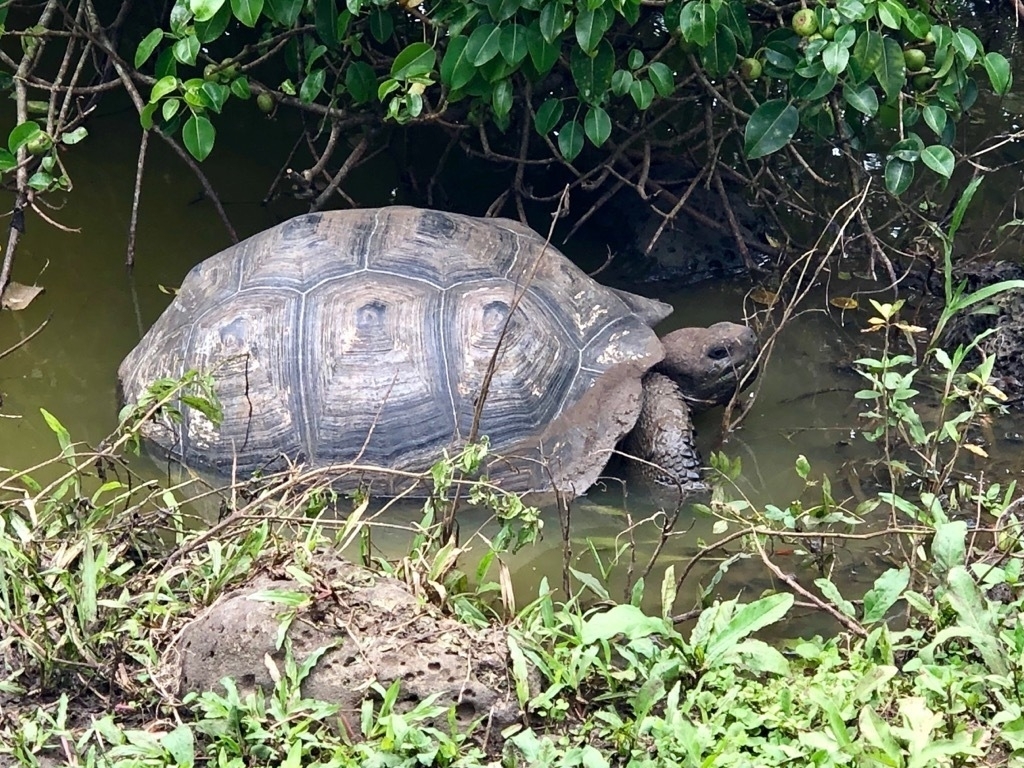
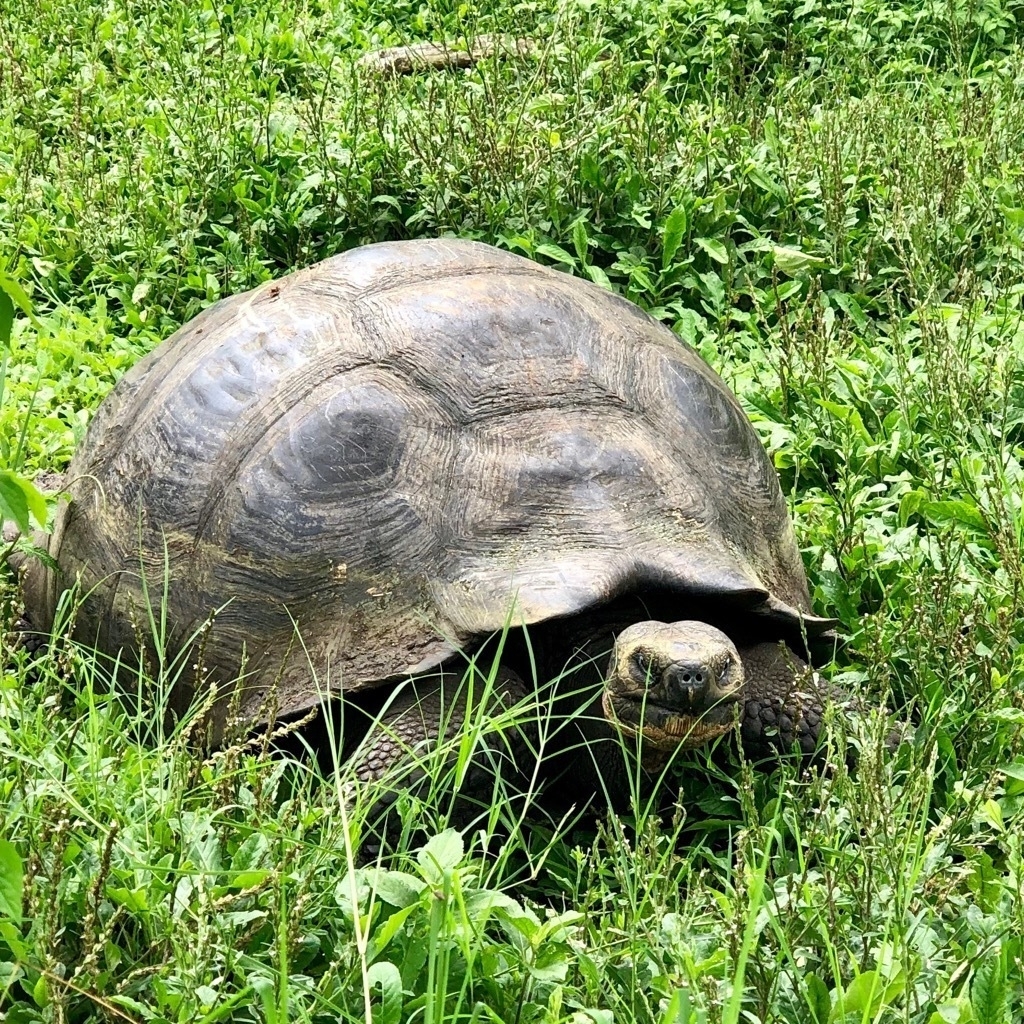
Another highlight of the day was our chance to participate in Celebrity Cruise Lines reforestation project. Many of the native Escalesa trees were choked out by the blackberries that were imported by the settlers on the islands. With a lot of work the blackberries have been culled, but now Celebrity is working to replant many many acres of forrest with native Escalesa trees. To date Celebrity and their guests have planted nearly 40,000 trees, and I’m happy that we got to participate.
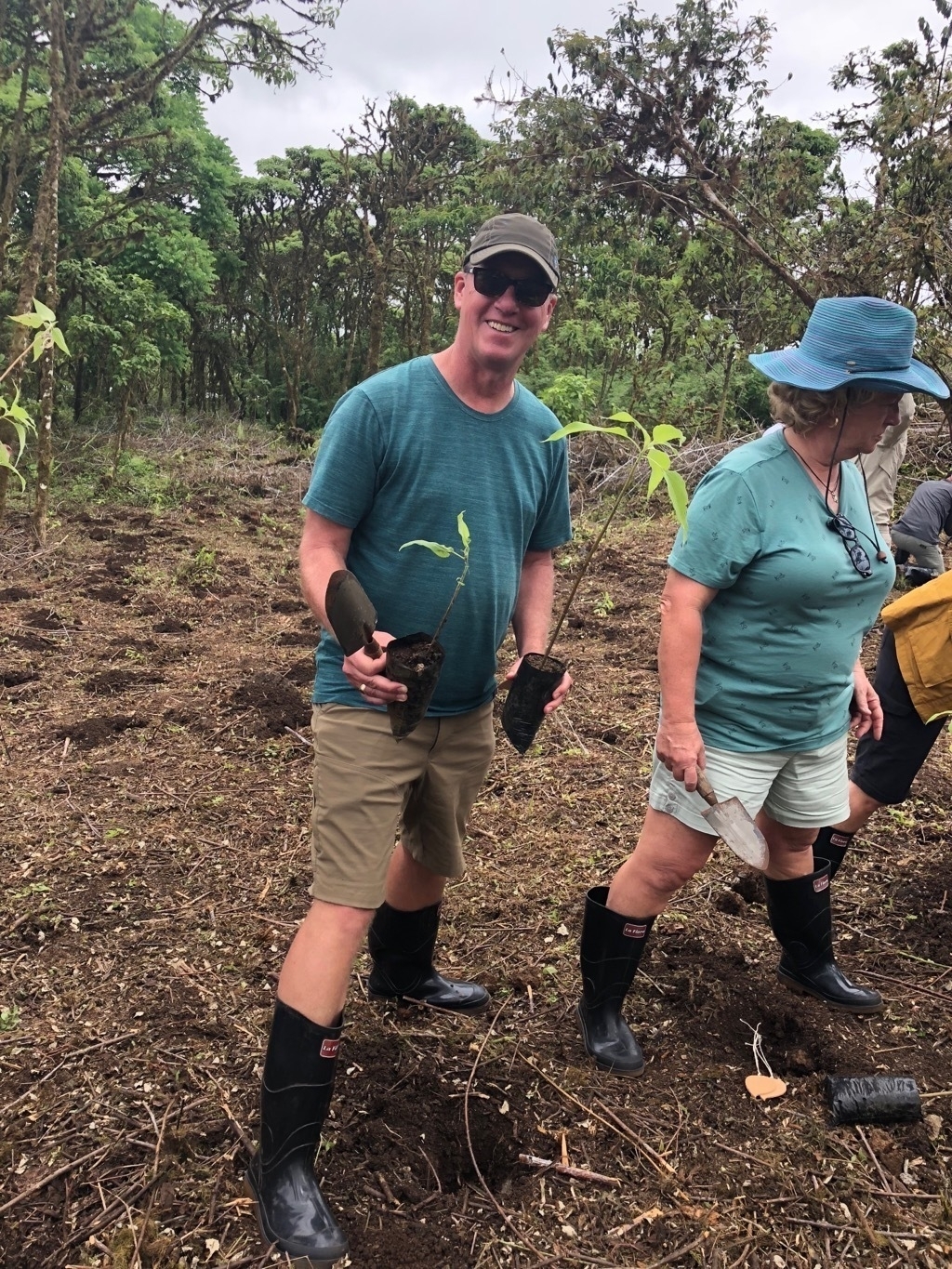
As an added bonus we all got to wear the super stylish rubber boots!
I 💙 Boobies
By this time of the trip the routine was well established. Breakfast in the morning, then off to the zodiacs for an adventure / hike on shore. Back to the ship for lunch and a rest during the worst heat of the day, then a late afternoon zodiac to another destination for another hike. This is definitely an adventure not a vacation! This afternoons hike was billed as the most difficult of the trip, because it involved a little rock scrabbling! As usual a few people joined that really shouldn’t have, you would think people would learn their limitations by this time. Anyway, after the rock scrabbling we were rewarded with a beautiful view of the beach.

Along the way we saw a lot of Blue Footed Boobies, we had to leave the trail to keep our distance from them several times as they just sit in the middle of the path looking at us. It was definitely worthwhile as this is probably one of my favorite photos of this whole adventure!
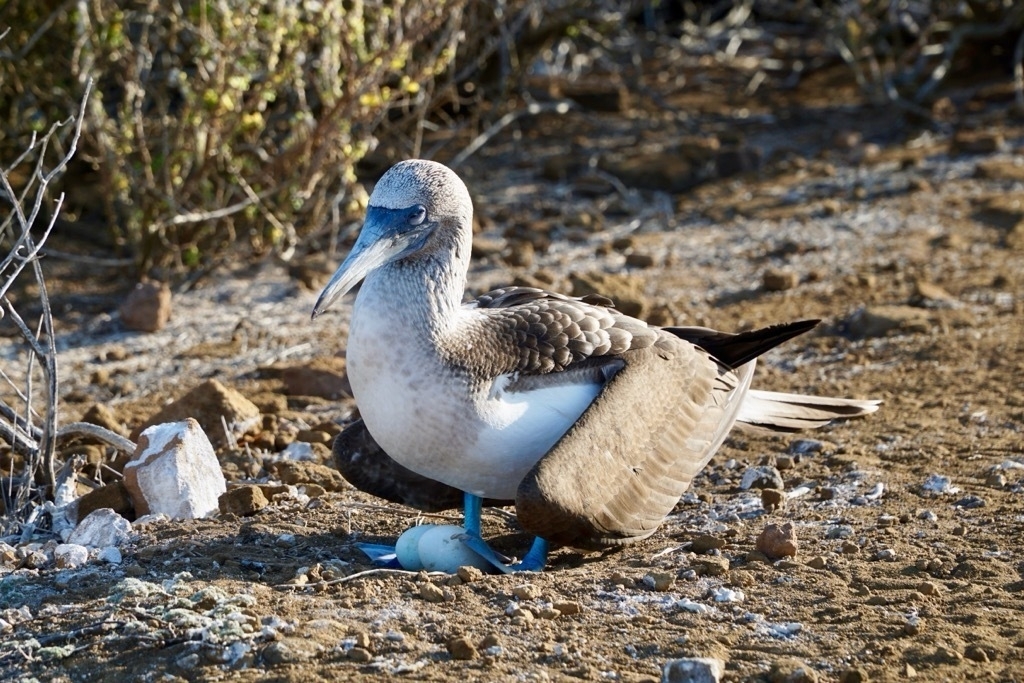
The blue footed boobies take turns on the nest, if you can call it that. It’s barely even a hole in the ground. Further, they don’t really even sit on the eggs, they kind of cradle them with their feet. Here’s a picture of the “changing of the guard”
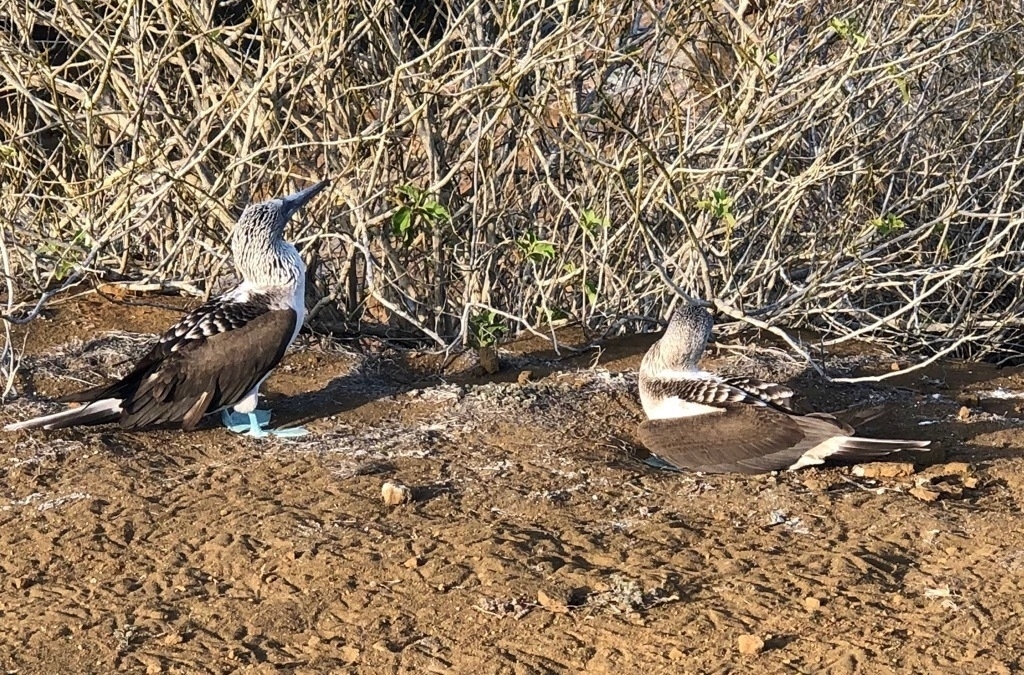
The reds are not nearly as interesting as the blues. They are arboreal and so you rarely see them on the ground. Their feet are red, but not bright red like the bright blue.
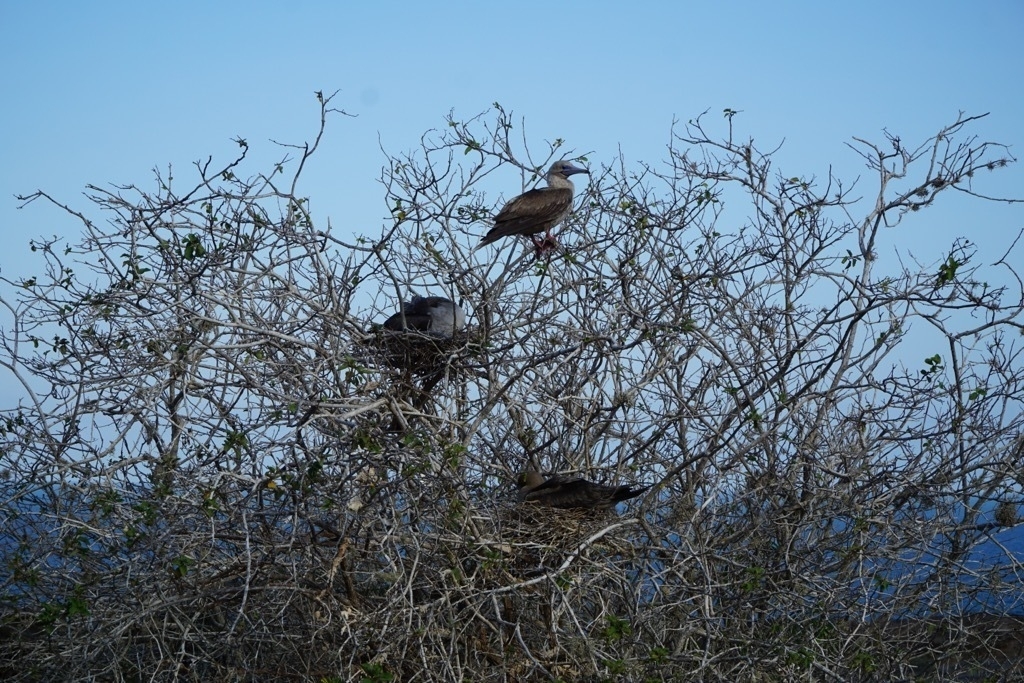
On the beach where we landed to start the hike was a small colony of sea lions.
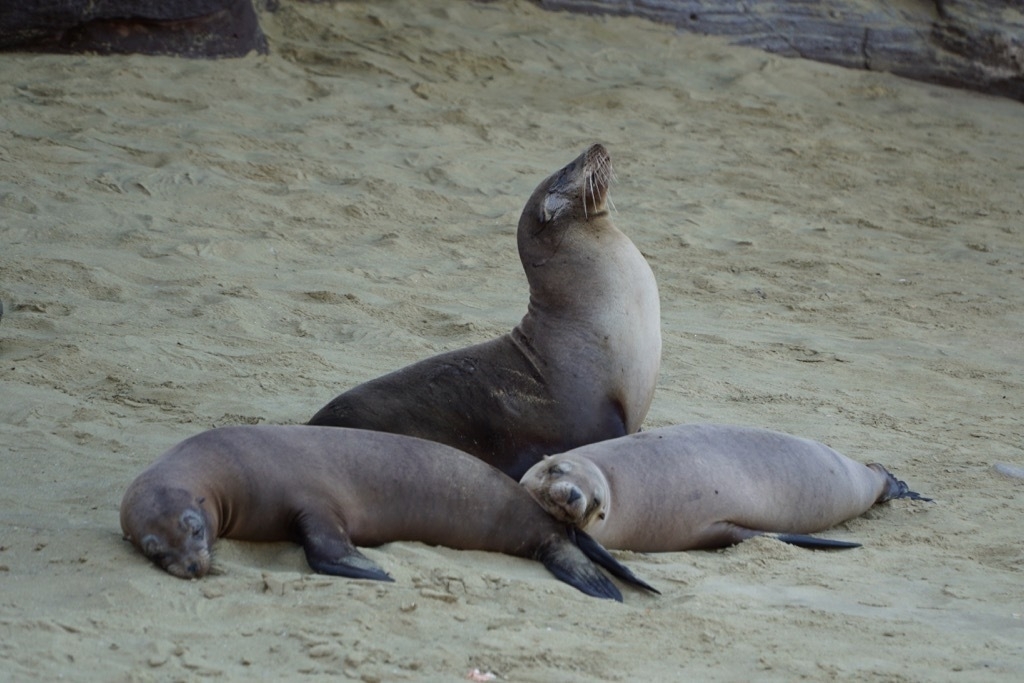
Galápagos Day 4 — Santa Cruz
The activity of the morning was a “long” walk around Dragon hill on Santa Cruz. The main objective was to see the Land Iguanas. These creatures have been restored to the island after they were endangered by feral dogs and goats that humans brought to the island. Santa Cruz is one of the few islands that is actually inhabited.
The cover picture for this post is actually of a marine iguana that was near the shore by a brackish pool.
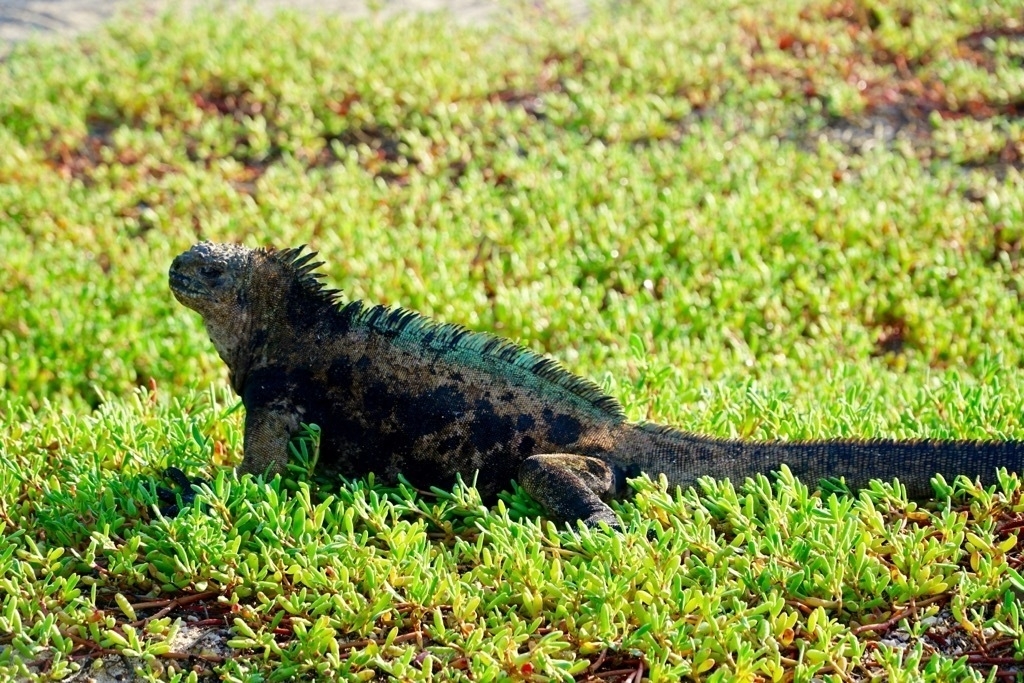
You can see a very clear difference in coloration and shape between the marine variety — which can swim using their tails for propulsion — and the land iguanas pictured below.
At one point they moved many of the Land Iguanas to an alternative island without any human habitation for them to come back, while they started a program to eradicate all of the goats and feral dogs. We actually saw a goat along the way, and the guides, who are also park rangers when they are on land, had to call it in so that the goat could be tracked down and captured.
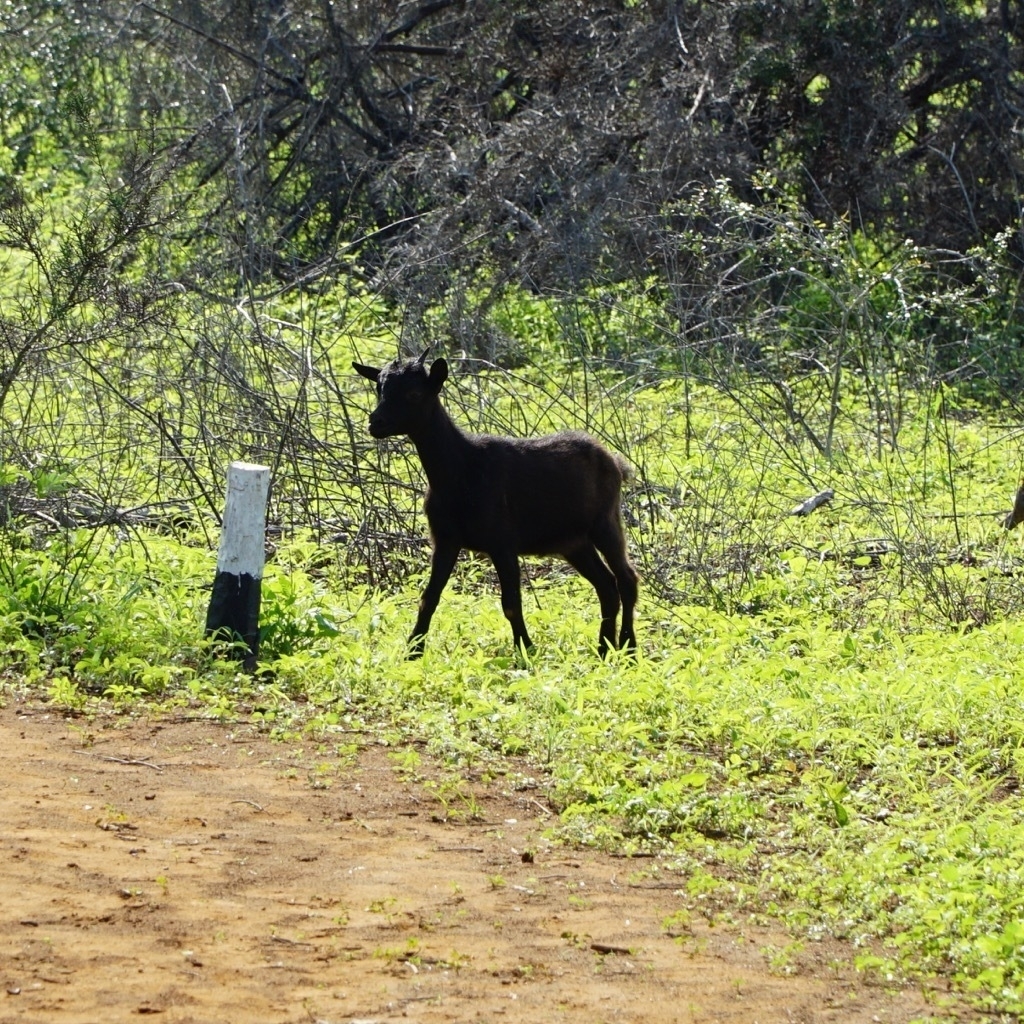
the walk started at 8:00 and already it was really hot. We began the walk on the beach and quickly passed by this beautiful brackish water pool.
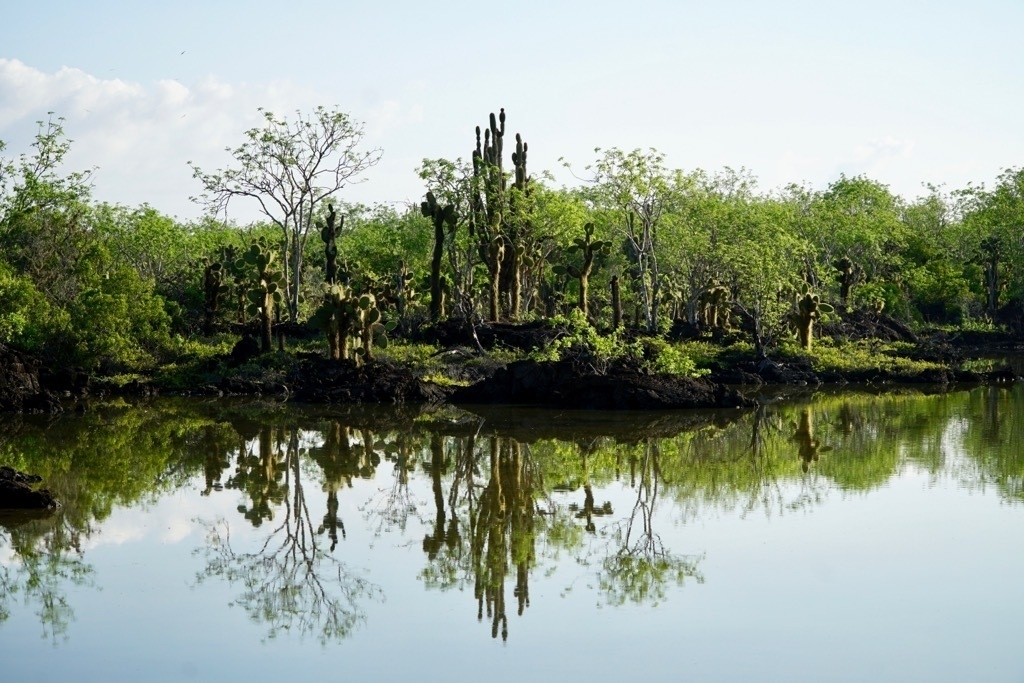
The path was very muddy from rain the previous night, and a few people from the group ahead of us called it quits and headed back to the beach. But we kept going, eyes peeled for our first siteing. The first Land Iguana we met was pretty hard to miss as he was right on the trail!
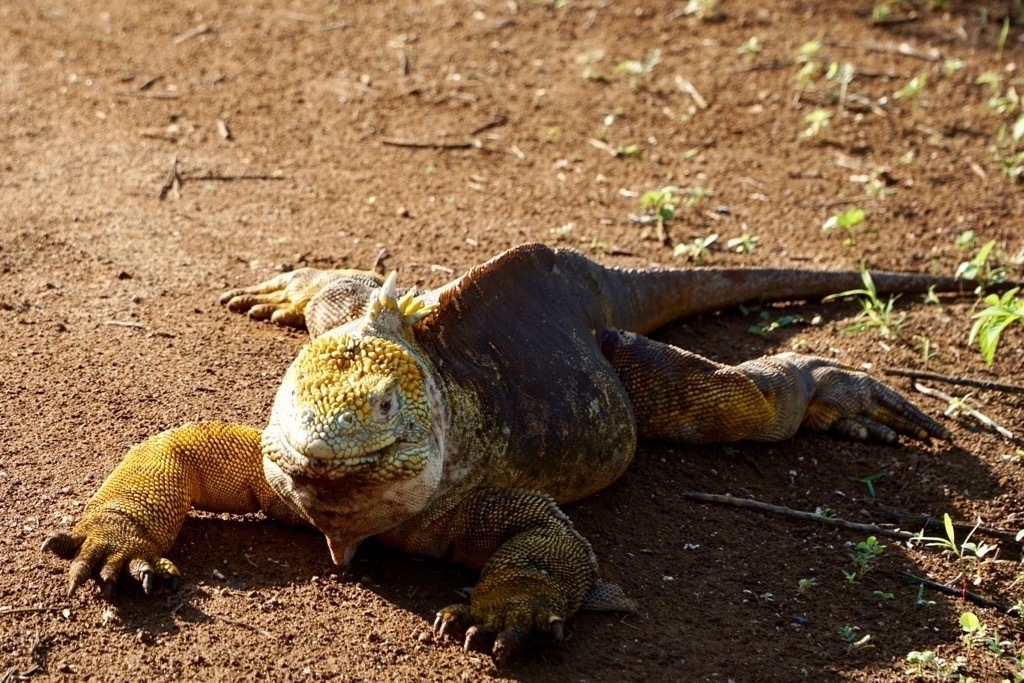
Once we spotted the first one we started to see quite a few of them. Some close to the path, some sitting right outside their burrows, some “lounge lizards” hanging out on a log.
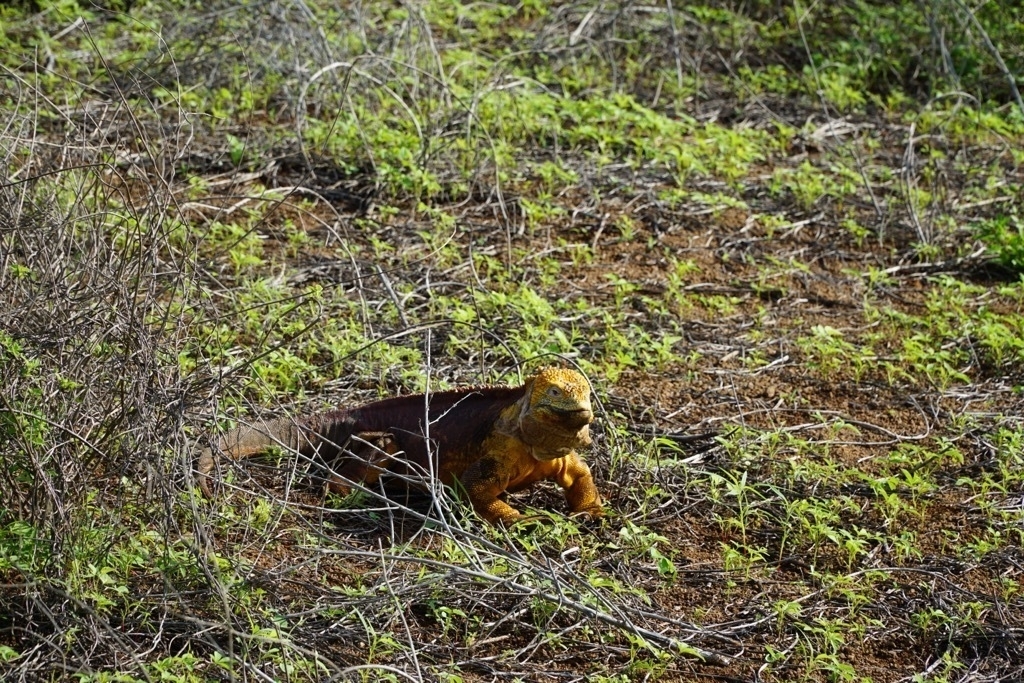
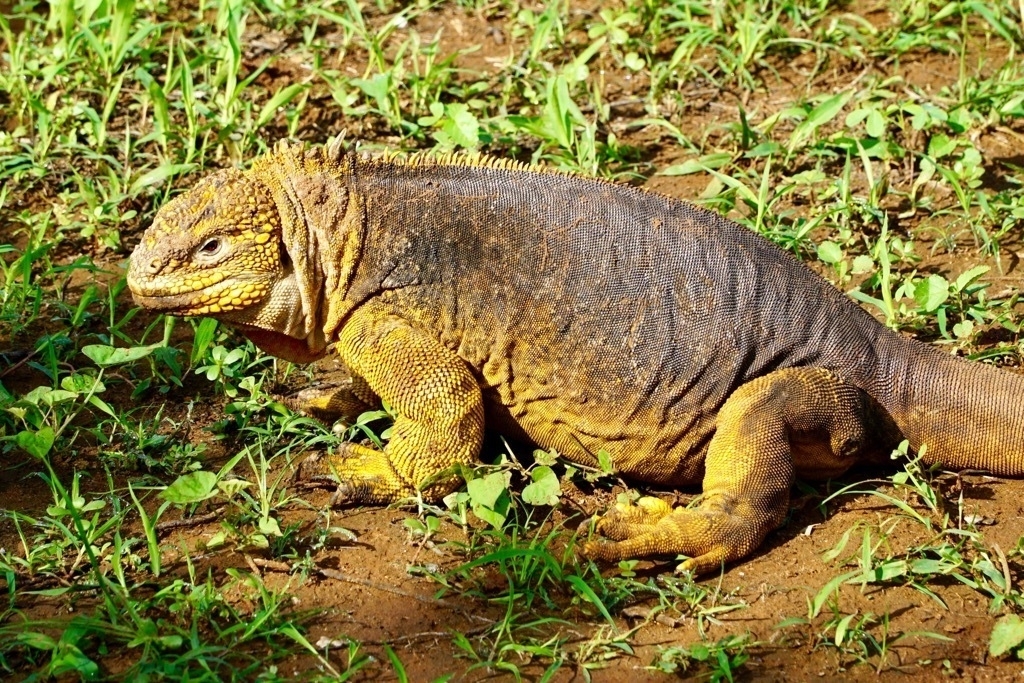
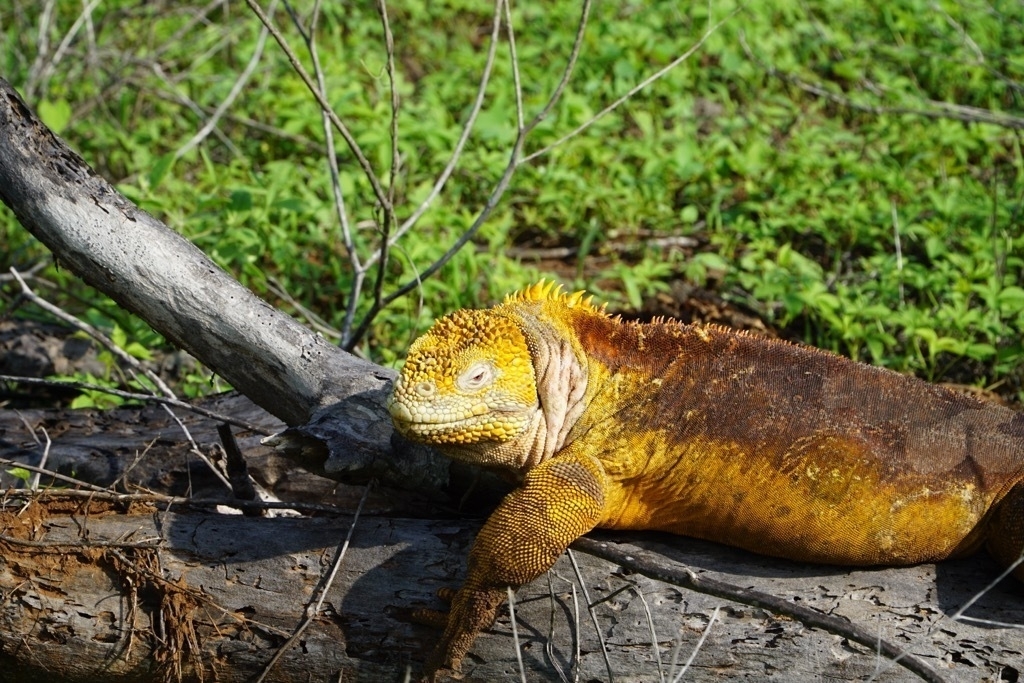
The scenery on the island was also very beautiful and couldn’t have been more different than our hike up the volcano from the day before.
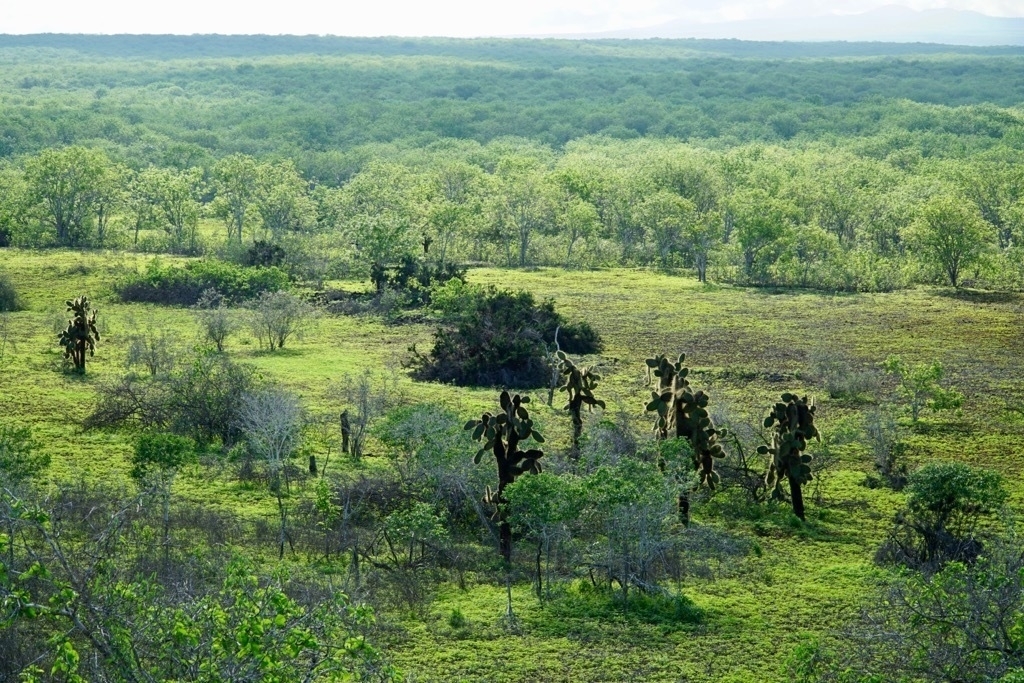
Afternoon Snorkel
In the afternoon we had a beach snorkeling stop. The water was pretty wavy and as a result the visibility was not very good. I was right next to a big sea turtle and I could easily have grabbed onto the shell to go for a ride. But you don’t touch the wild animals so I just followed it and admired it s grace.
The real highlight of the snorkeling trip was the Pelicans. After coming back to shore there were about 3 brown pelicans that decided it was feeding time. They are “shallow plungers” so they swoop up into the air about 15 to 20 feet and then plunge awkwardly into the water to capture a fish! They were definitely not deterred by all of the humans in the water as several swooped right next to people! The pelicans were fine, but the people were a bit shocked!
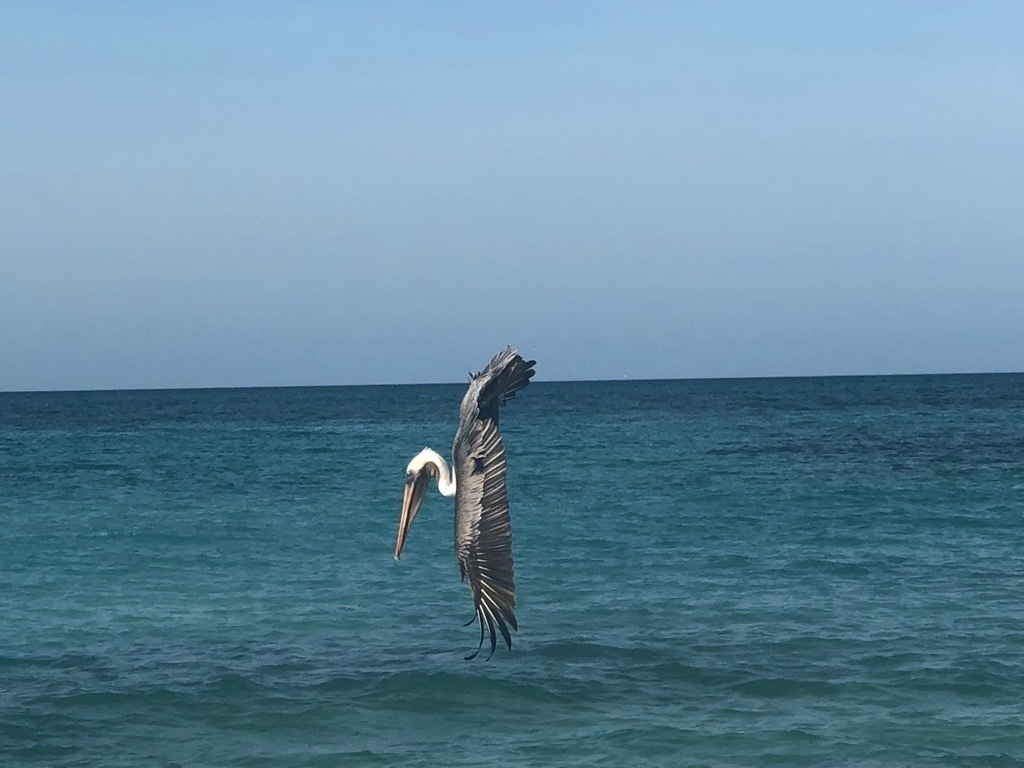
Galápagos Day 3 — Pinnacle Rock
If you google Galápagos Islands you will almost certainly see this picture:
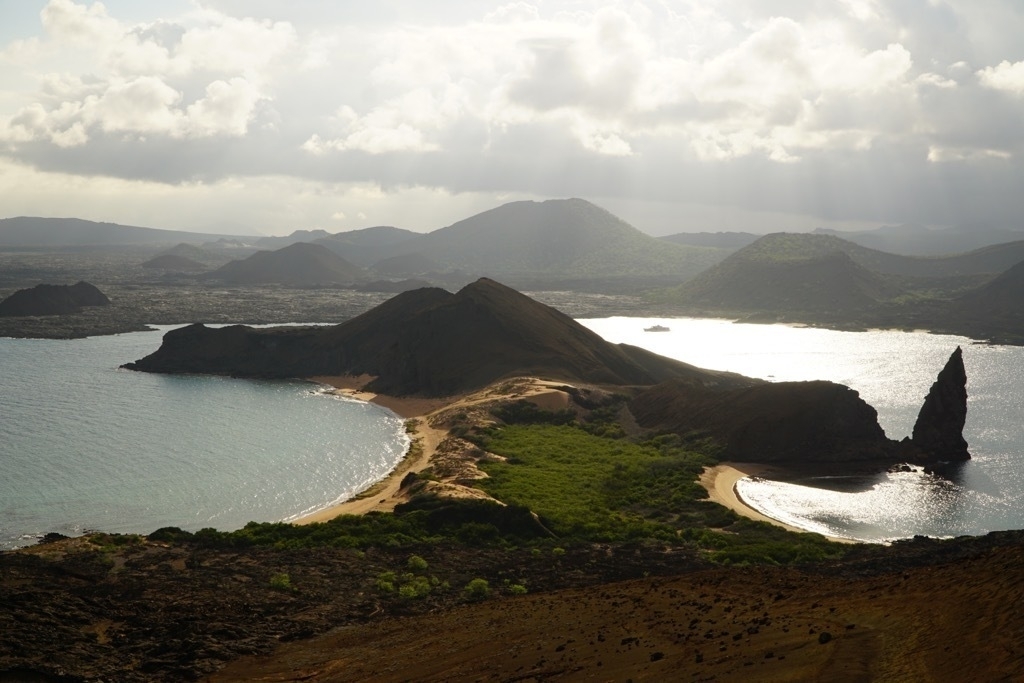
You will likely see even better photos than the one above as we were there at the wrong time of day for optimal photo lighting.
The hike was mostly just climbing the 366 old wooden stairs and many boardwalks to the top of the volcano where there is a great viewing and picture taking spot. Along the way we stopped to learn a bit about volcanology, spatter cones, calderas, and craters.
The naturalists on board are all great and really knowledgeable. Most, if not all, of them were born on the islands and you can tell they all really love it.
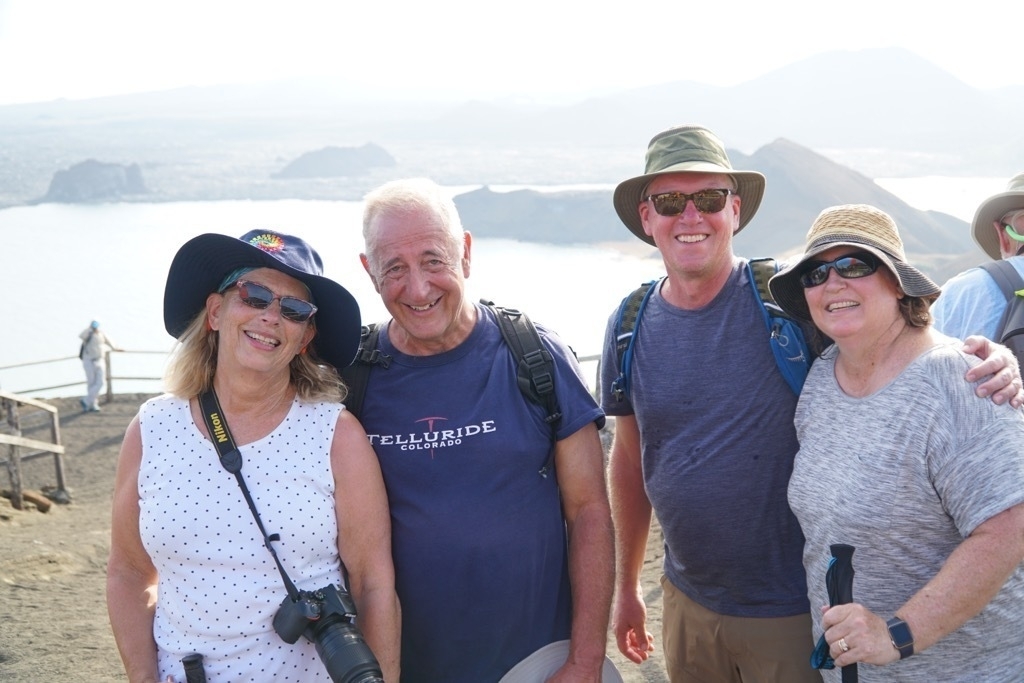
Galápagos Day 2
Looking out the window in the morning we couldn’t see anything. Had our luck changed? Were we going to have a rainy day after all? I went up on deck to investigate and was happy to see that it was just a dense fog. Caused by the cold water currents running up against the Galapagos ridge. It would burn off. All credit to Ann who insisted that we take the 10:00 excursion rather than the 8:00 excursion. This is what the fog looked like just before we boarded our zodiac at 10.
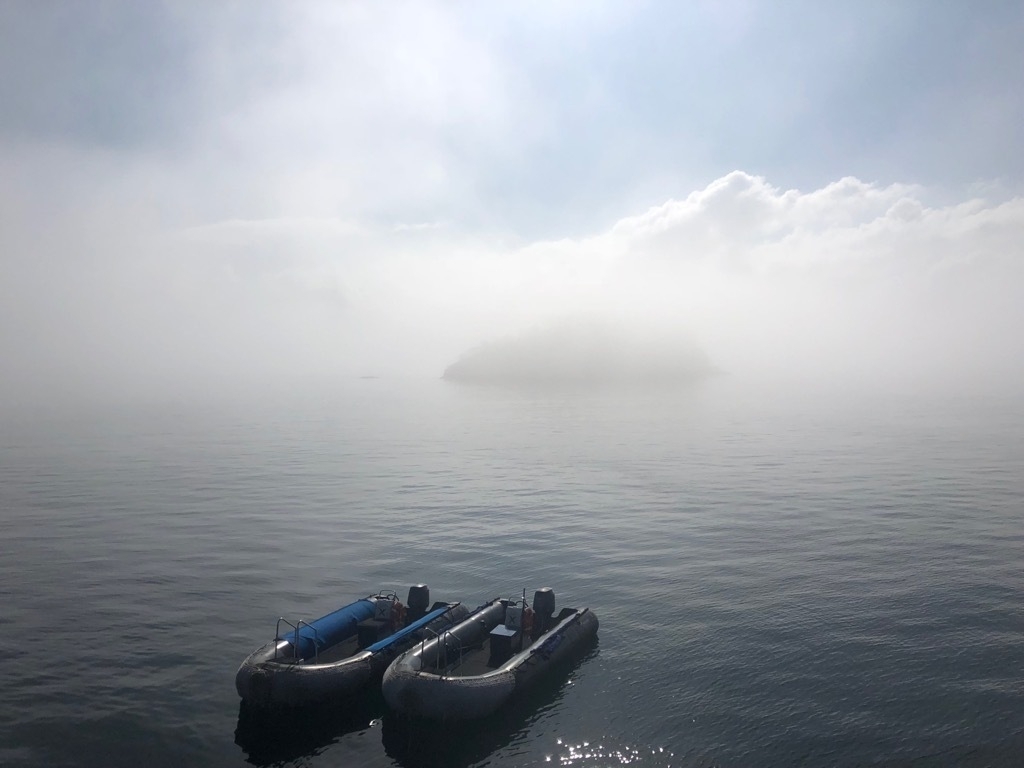
We later learned that it was so foggy during the 8:00 trip that one of the zodiacs took a wrong turn in all of the mangrove and got lost for a bit. Apparently everyone was taking it in stride and singing the theme song to Gillian’s island (except for one passenger who was not amused). I almost wish I was on that boat so I could tell the story in more detail. Here you can just barely make out our ship in the fog from a distance.
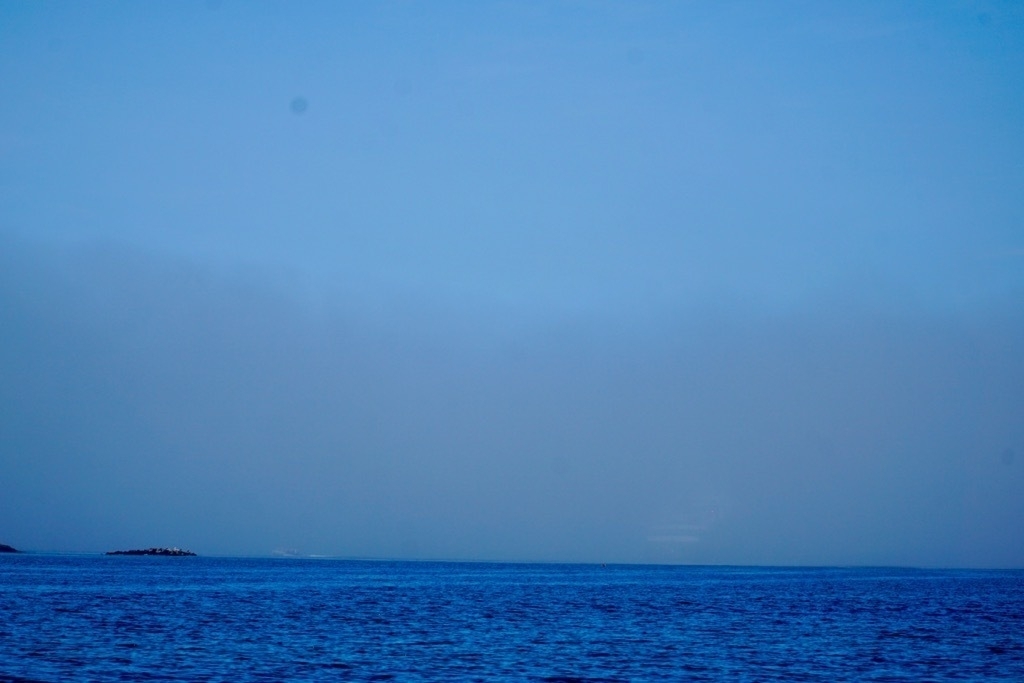
We were headed into a huge lagoon protected by mangroves but on the way we got some good sitings of a few of the marine birds. Below is the famous Blue Footed Boobie. Yes, I kind of giggle inside like a seventh grader every time I say that. The reality is that the name comes from the fact that they act like clowns during their mating dance. Kicking their legs up and flapping their wings and acting like fools.

We also got very close to a few brown pelicans.
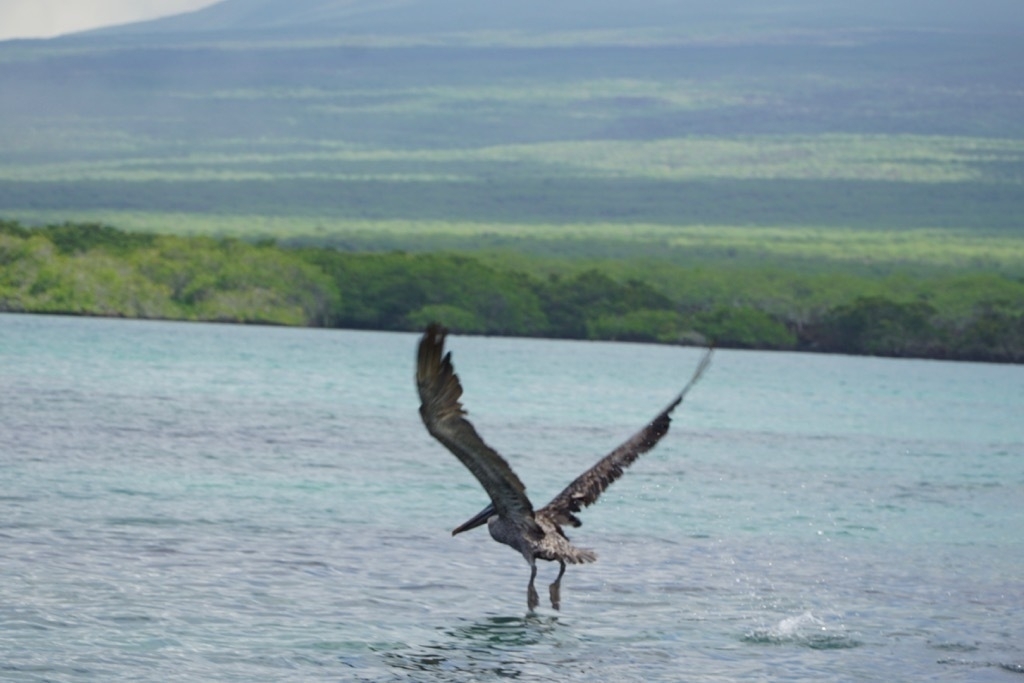
And we saw the Galapagos Penguin! The second smallest penguin in the world.

They look kind of dopey and slow when they are out of the water but when they are in the water they swim fast and graceful.

We saw turtles all over the place poking their heads out of the water, but it was not until the afternoon when we did our deep water snorkel that we really got to have a great view of the turtles.
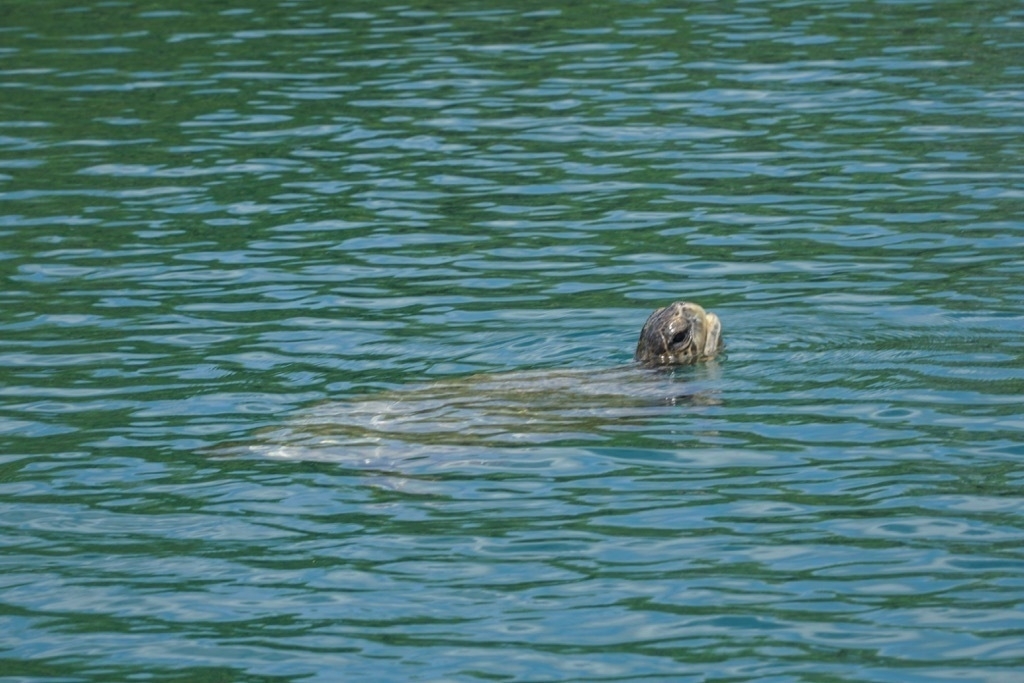
Toward the end of the trip we were way back amongst the mangroves and we saw a sea lion sleeping on a branch just a few feet above the water. We also had a very close encounter with a Great Blue Heron
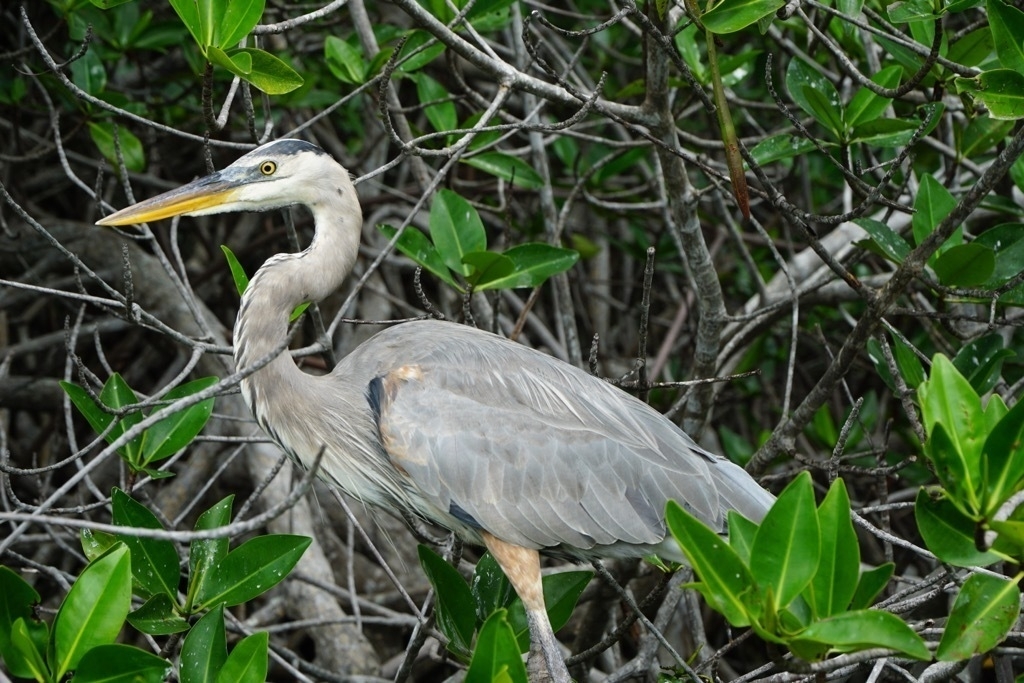
We were also lucky enough to see some golden rays swimming just beneath us. Too bad that we were not able to capture them on camera.
Hike at Tagus Bay
The afternoon was in Tagus bay where we started with a drift snorkel. It was great, we saw a lot of sea turtles, and fish, but the most amazing was when I got to watch one of the penguins swimming underwater.
After we dried off from the snorkel trip we headed out for the “fitness hike” This was billed as a faster paced walk with fewer stops but the same great scenery. With people of all different ages on the cruise the walks tend to go at the pace of the slowest person in the group so we thought this would be a good option. And it was.

We climbed 150 stairs and then walked a bit to have a great view of the bay and this highly salty inland lake.
After a mile we came to the end of the trail where we could see the difference between the two sides of the volcano we were climbing. We were climbing the wet side and were suddenly treated to a huge vista of the dry side. You could images that you had just landed on mars!
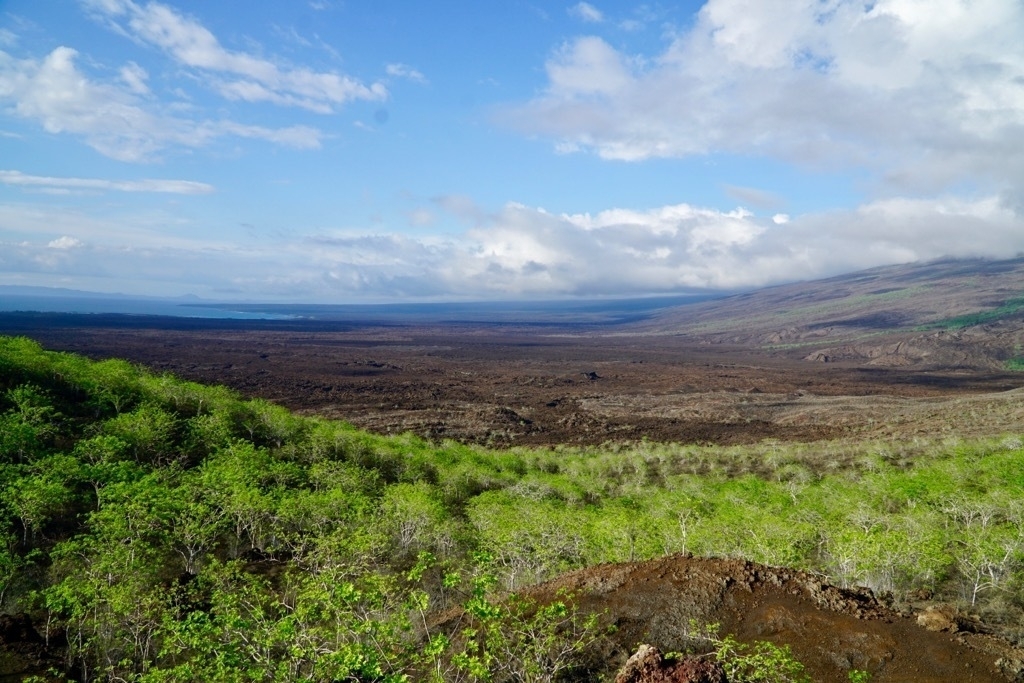
We took another short zodiac ride to view the geology of the volcano and some of the wildlife. Here you can see the layers where the older layers have oxidized!
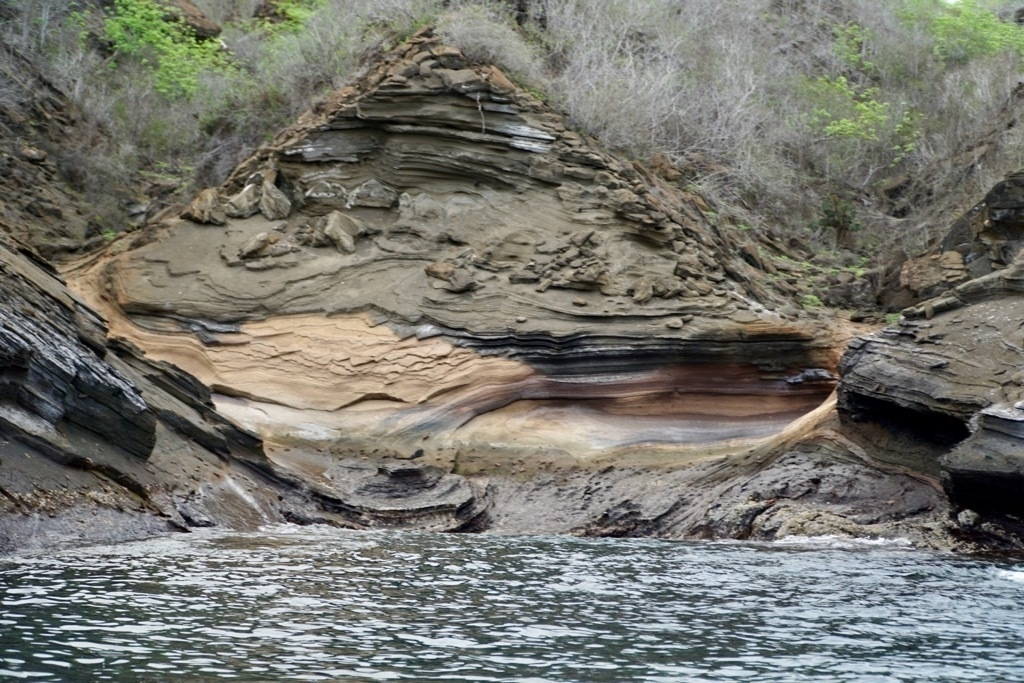
After we got back on the ship we had time to relax with a happy hour drink and enjoy the amazing sunset.
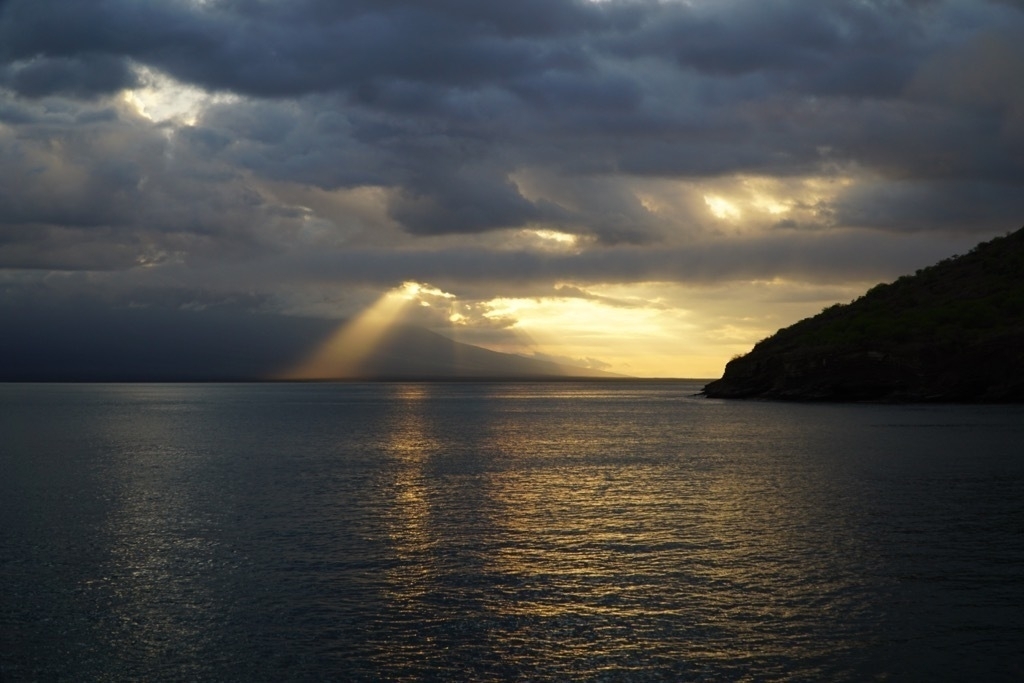
Up next was a delicious dinner where we watched one of our exhausted fellow passengers fall asleep right at her table with conversation and laughter going on all around her.
After dinner there was a small party to celebrate crossing the equator on our way around the north end of Isabella island. We were all encouraged to do the limbo and imitate one of our favorite Galapagos animals. As a group we did the blue footed boobie dance, and narrowly lost the contest to a couple imitating sea lions.